#Crawler Camera System price
Text
Crawler Camera System Market - Major Industry Growth Driving Factors
Crawler Camera System Market – Major Industry Growth Driving Factors
This report studies the Crawler Camera System Market with many aspects of the industry like the market size, market status, market trends and forecast, the report also provides brief information of the competitors and the specific growth opportunities with key market drivers. Find the complete Crawler Camera System Market analysis segmented by companies, region, type and applications in the…
View On WordPress
#Covid-19 Impact Analysis#Crawler Camera System#Crawler Camera System forecast#Crawler Camera System Industry#Crawler Camera System Market#Crawler Camera System price#Crawler Camera System report#Crawler Camera System research#Crawler Camera System share#Crawler Camera System trends
0 notes
Text
Robot vacuum cleaner reviews
Robot vacuums never obtain bored or distracted, and they do not mind functioning on a daily basis. In the majority of homes, they keep the floorings neat with barely any initiative-- pet hair as well as crumbs just disappear prior to you also discover a mess. After examining lots of robot vacuum designs over the past a number of years, we assume the majority of people ought to look first at the straightforward, reliable iRobot Roomba 614 or the Wi-Fi-- connectable Roomba 675.
iRobot Roomba 614
Reliable, repairable, as well as great on carpets
This tried-and-true robotic vacuum is much more resilient and also repairable than similar robots from other brand names and is much better at cleansing carpets as well. It's an active navigator that hardly ever gets stuck, though it works best when it only needs to clean 3 or four rooms each time.
Roomba 675
Reputable, repairable, and linked
This is basically the exact same crawler as the Roomba 614-- plus Wi-Fi connectivity that allows remote control from a smartphone application, scheduling, as well as assimilation with some preferred smart-home voice aides.
We have actually been testing Roomba 600 series robots at Wirecutter because 2012, as well as nothing else budget-friendly robotics are as sturdy as these. Even if a part does break down after a few years, it's very easy to swap in a repair in your home, and also iRobot has an outstanding performance history for maintaining spare parts offered for every version the firm has actually ever before made. The Roomba 614, 675, and various other 600 collection versions are additionally better at cleaning carpets than various other budget friendly crawlers, due to the fact that they're the only ones with 2 brush rolls. The navigation system is semi-random, so the crawler looks rather silly as it bashes around under furnishings and also periodically drives in circles, yet it's flawlessly efficient for cleaning smaller sized spaces. (One of our upgrade choices will function much better in a larger room.) And it hardly ever obtains stuck under furniture. These robots are a little taller, louder, and rougher than other budget friendly bots like the Eufy RoboVac 11S, however we believe the majority of people will discover that the added durability is worth it.
Eufy RoboVac 11S
Silent, nimble, and cost effective
This cost effective robot vacuum cleaner is the quietest we have actually ever before evaluated and fits under more furnishings. While it works best in little spaces, it seldom gets stuck and also does an excellent job on bare floors as well as short-pile carpets. Nevertheless, it's not as long lasting as a Roomba.
No other robot vacuum cleaner mixes right into the background like the Eufy RoboVac 11S. It can clean up practically every nook of your home, yet you'll hardly notice it. That's mostly because it appears more like a fan than a vacuum cleaner, so even if you go to home while it's running, it should not hop on your nerves. It's likewise unlikely to obtain stuck as well as quit midway through a cleansing session. While it can't clean plush carpets as well as the Roomba 675, it's strong enough to maintain bare floors and also short-pile rugs clean. Like the majority of affordable robotics, it depends on a semi-random navigating system, which functions well in smaller rooms yet can have a hard time in larger houses. The primary trouble-- and the reason that it's no longer our leading choice-- is that it doesn't seem to be virtually as long lasting as the Roomba 600 series, according to some visitor comments, and also the majority of its huge parts (like its wheels as well as brush transmissions) can not be changed even if you intended to fix it. Eufy makes several comparable models, consisting of the RoboVac 11S Max, RoboVac 15C, RoboVac 30, and RoboVac 30C Max, which offer extra attributes like Wi-Fi, extra suction, and tape you can use to position borders your robotic will not cross. Our recommendations: Try to buy Eufy crawlers when they set you back less than $230 or, if possible, also $200. Rates on Eufy crawlers can turn hugely, and also an agent from Eufy informed us that you should not pay complete rate because price cuts are constantly around the corner.
Roborock S4
Supersmart bot, excellent price
This robot vacuum can promptly and with dignity browse huge spaces, as well as it uses a durable as well as adaptable barrier-setting function via mobile phone application for a whole lot less money than anything we have actually seen up until now.
The Roborock S4 is just one of the most effective navigators we've evaluated, able to beautifully avoid most barriers and promptly cover a lot of ground. That makes it wonderful for huge homes-- as well as for proprietors who can not stand to view their crawler aimlessly bonk about. It's one of the few robots (until now) that allows you both established undetectable do-not-cross lines as well as tell it to tidy specific rooms in your house (while avoiding others) via an interactive map in a smart device application. That would all go over in a robot at any price, however the Roborock S4 is also one of the most budget-friendly robotics with any kind of interactive mapping functions, let alone all of these in one package. The disadvantages: We're not sure just how sturdy Roborock bots are (it's a more recent brand name), and while it's a sufficient cleaner overall, it doesn't tackle rugs in addition to other robots at this rate.
iRobot Roomba 960
Outstanding cleaner, wise sufficient
The 960 has a performance history for integrity and provides outstanding carpet-cleaning performance-- especially with animal hair. Its active nav system consistently and thoroughly cleans up huge rooms, though this bot is missing out on a couple of innovative features.
The Roomba 960 builds on the exact same base as the active, sturdy 600 series that we recommend. However it includes a video camera and also a few various other sensing units to the nav system to create a map of your layout as it cleanses, so it looks smarter than the cheaper Roomba (and also Eufy) as well as won't miss any big places even if it's tackling a massive house. It's a general outstanding cleaner and particularly efficient obtaining lots of hair out of thicker carpets, plus it can attach to Wi-Fi. The disadvantage is that unlike a great deal of other robotics in this price group currently (consisting of the Roborock S4), the Roomba 960 doesn't have any type of kind of interactive mapping function-- you can't set up no-go lines or divide your floor plan into specific areas. So it really feels a little bit behind the moments.

#robot #vacuum #reviews
2 notes
·
View notes
Text
Fulfill Untapped Customer Demands Through Your Faceted Navigation
Faceted navigation allows customers to narrow down search results based on specific product attributes. They typically exist on Product Listing Pages (PLPs) and are a great way to help users intuitively discover products but managing this filtering system is a common SEO challenge. Crawling and indexation need to be controlled.
However, if we look beyond their inherent functionality, facets can offer us considerable potential. By centering your secondary navigation on long-tail keyword opportunities, you’ll be able to strategically utilize consumer intent, secure additional web conversions, and boost revenue levels.
Match consumer intent with long-tail search queries
Having an established brand and a solid domain backlink profile won’t guarantee success. This is great news for smaller brands, as industry giants aren’t necessarily going to win at this game.
If we search for “long sleeve wedding dresses”, we can see how David’s Bridal’s optimized facet page (Domain Authority: 67/100, Page Authority: 47 / 100) has obtained the top ranking position, while Nordstrom’s result (Domain Authority: 87/100, Page Authority: 39/100) appears in the third position for this particular query. We’ll take a look at what makes this page so effective later.
When looking at how we can optimize faceted navigations, it’s important to recognize that product attributes convey consumer needs and aspirations. If, for example, I’m looking for a wedding dress, then I may tailor my search by the color, fabric, neckline shape, and the sleeve length.
According to the search demand curve, long-tail queries account for up to 70% of all organic searches. They are highly targeted queries that offer big traffic-driving opportunities.
In the last few years, we’ve seen a big shift in the industry towards capitalizing this intent with long-form content. Blog articles and style guides have become the go-to methods for many to capture these visitors, as we can see from the examples taken from Marks & Spencers’ "Inspire Me" section:

People often look for inspiration when they’re shopping, and these pages provide an effective way to add more internal links to category and product pages. But relying on this approach is one-dimensional, given that these deeper content pages tend to have lower PageRank. An extensive amount of time and effort will, therefore, be required to achieve the desired result.
In comparison, Product Listing Pages usually target broader search terms, and faceted navigations typically exist as passive functions. This is because they’re often blocked from crawlers, making them devoid of any SEO value. Waterstones (a well-known British bookstore) is one retailer that applies this rule for their on-page filters:
In this particular example, I’ve applied a filter to only show me books for 5 – 8 year olds, but the appended URL (https://ift.tt/3xrpOJS) is blocked in the robots.txt file. This is going to prevent such pages from being served in the SERPs despite them having the potential to meet specific customer needs. This shows that there can be a fundamental disconnect in matching customer intent to the pages we’re providing them in the organic results.
From the diagram below, we can see how editorial content typically focuses on the “awareness” and “interest” stages, whilst Product Listing Pages tend to be more in line with the “consideration” and “purchase” phases:
Serving the right content to users throughout their buying journey is pivotal to success. For many retailers, competitors are continuing to prioritize broader, high-volume keywords in saturated markets. They’re targeting the same terms to secure a proportion of the same search traffic. This is a very challenging prospect to face, and without carving out a gap in the marketplace, they won’t necessarily deliver the results they seek to secure. Likewise, relying on informational guides to target long-tail keywords means that you’re missing a large percentage of users who have very specific buying requirements. Yes, they’re ready to make a purchase!
By shifting your focus to address your customer’s real needs and expectations, you’ll be able to deliver a satisfying, frictionless experience at every interaction and all the way through to that final purchase.
The solution
Step 1: Conduct long-tail keyword research
Build a really comprehensive view of your potential customers by harnessing data from a variety of sources, including:
a) Keyword research tools like Moz, Google Keyword Planner, and Answer The Public.
b) The SERPs — get inspiration from the auto-suggest results, People Also Ask, and the related search links at the bottom of the page.
c) Competitor activity — aside from using SEO monitoring software, you can use a data mining extension tool like Scraper, which will extract faceted options directly from competitor Product Listing Pages. These tools are often free to download and allow you to quickly transfer product categories.
d) Your Google Search Console, Analytics, and PPC accounts to determine which keywords and URLs are securing the highest number of visits and web conversions. Internal search data can also give you great consumer insights.
e) Speak to your merchandising team to understand product demands and fulfillment capabilities.
Step 2: Group into meaningful sub-topics
Once you’ve collated all this information into a spreadsheet, you’ll be able to discover long-tail, consideration-orientated keywords. While individually they may not boast huge monthly search estimates, they can collectively highlight where purchase intentions can be better fulfilled.
To help illustrate this point, we can look at a small subset of lingerie keywords and the facets the searches represent:

From the table above we can quickly see a pattern emerging with color and material variations appearing across the search terms. We can then substantiate this information with session and revenue estimates with the use of a recognized CTR model. This enables us to help forecast the potential organic uplift and quantify the size of the prize for a number of different scenarios that are on offer from each new facet combination. This may include estimations for securing position 10, 7, 5, 3 and 1 in Google.
One thing to note here is that it’s worth excluding synonyms, as they will falsely inflate your calculations. An example here would be to exclude “storage drawers” (22.2k monthly searchers) when reviewing the performance for “chest of drawers” (201k m/s). Including both variants will cause a false positive result and will lead you to draw incorrect conclusions.
Step 3: Dig deeper into broader terms around offers, ratings, and price
These product filters are found in the “Sort” dropdown box and, from my experience, these are set to “noindex” from the outset as they simply allow users to re-order page results. Certainly, content management systems like Shopify and Shopware have this as a default.
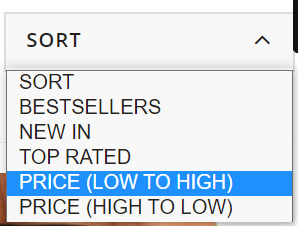
This makes sense since their purpose is to allow visitors to simply sort or narrow page content rather than offering alternative results and additional value (which is offered through faceted navigation). As such, filter typically produce duplicate results which should not be discoverable beyond the immediate moment. But this hard-and-fast rule doesn’t always apply perfectly in the real world. This is why we need to look at our individual industries and understand what’s important to our unique set of customers.
If we look at the world of gifting, we often see people shopping with a particular budget in mind. Therefore, terms like “birthday gift under £20” (40 m/s) or “Secret Santa gift under £10” (2.9k m/s) are reasonably common, and opening up relevant listing pages could be useful for shoppers.
Step 4: The technical steps
Facet taxonomies are hugely complex and the number of attributes that can be strung together increases with the size of the domain. We, therefore, need to carefully manage the flood gates and mitigate against any potential risks including crawl inefficiencies and link equity dilution.
We can do this by:
1. Avoiding thin/doorway pages by regularly re-assessing your product offering. For instance, you may consider there to be little value in creating a new listings page if you’re selling a very small range of low price point products. In this case, you may decide against opening up an additional Product Listing Page when you sell as few as 10 eligible products. However, this is not a fixed rule, so it’s quite possible that your criteria may be lower for particular product lines. Either way, these numbers will change over time. Consider seasonal trends, when new collections are launched, and when they become discontinued. Setting up a product retirement strategy to manage expired products and categories at scale in parallel with this step is also highly recommended.
2. Prevent content cannibalization by arranging selected facets according to their value and significance. “Size” is very important for some electrical goods like TVs, laptops, and cameras, but is less so for beauty accessories or vacuum cleaners. You must also make sure page content is distinctive and reflects the focus of your chosen facet(s). Refer to step 5 for more details.
3. Follow the sequence in which adjectives and facets are typically selected by your customers. This can vary depending on where your audience lives. So, whilst products generally have five or more distinguishable features, English vernacular determines that we use more than four adjectives (e.g. size + color + material + shape) to describe something.
4. Control the controllables by dealing with overlapping variations. This typically occurs when multiples co-exist and each exhibits good search metrics. For instance, it’s reasonable for someone to simultaneously look for several color and/or fabric combinations in the different ways below.
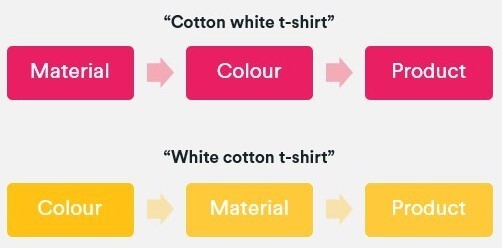
When this situation occurs, we should follow the same linguistic rules as above and choose a preferred sequence. In this case, it would be color + material + product type.
In comparison to the noindex tag suggested for on-page filters you should canonicalize unnecessary facets to their parent page (remembering that this is merely a hint and not a directive). This will enable you to control how crawlers deal with highly comparable result pages and will, therefore, help to prevent your site from being demoted in the SERPs. Dynamic search parameters should continue to be defined with a “noindex, nofollow” meta robots tag, disallowed in the robots.txt file, and configured through Google’s URL parameter tool (within your Search Console account) to tell crawlers the purpose of your parameters and how you would like them to be treated. This is a helpful guide on parameter handling for Googlebots, but bear in mind that this last tip won’t influence how Bing or Yahoo user-agents interpret these pages.
5. Open your facets in phases and cultivate it into a test-and-learn process. This will enable you to identify issues a lot sooner and implement facet-wide solutions in a timely manner. Without having to unravel these additional layers of complexity, problems such as crawl inefficiencies, PageRank dilution, or excessive indexation can be swiftly resolved.
To show you what this could look like, I’ve provided a phasing plan that was created for one of our e-commerce clients. Our research showed a significant SEO opportunity for opening up some of the facets and filters: potential +£263Kpcm for the “colour + type” facet (UK):
What’s more, when we extended our forecast to include other facet combinations, we calculated an additional revenue opportunity of up to +£207K/pcm (before filtering out combinations with no products offering).
Step 5: Optimize your facet URLs
Optimize your new facet category URLs to establish relevancy for your selected search terms. The key on-page elements to focus on include:
URL
Page title
Breadcrumb anchor texts
H tags
Content snippets (e.g. introductory text and FAQ copy)
Image ALT texts
Product names
Link out to similar facet category pages (i.e. via a “You May Also Like” feature box)
David’s Bridal is a good example of a retailer that has done this well. Looking back at the ‘Long Sleeve Wedding Dress’ Product Listing Page, we can see that they’ve curated unique content and followed fundamental optimization tactics on the landing page in a way that feels helpful to the user.
URL: davidsbridal.com/long-sleeve-wedding-dresses
Page Title: Long Sleeve Wedding Dresses & Gowns | David's Bridal
Meta Description: Do you dream of wearing a long sleeve wedding dress on your big day? Shop David's Bridal wide variety of wedding gowns with sleeves in lace & other designs!
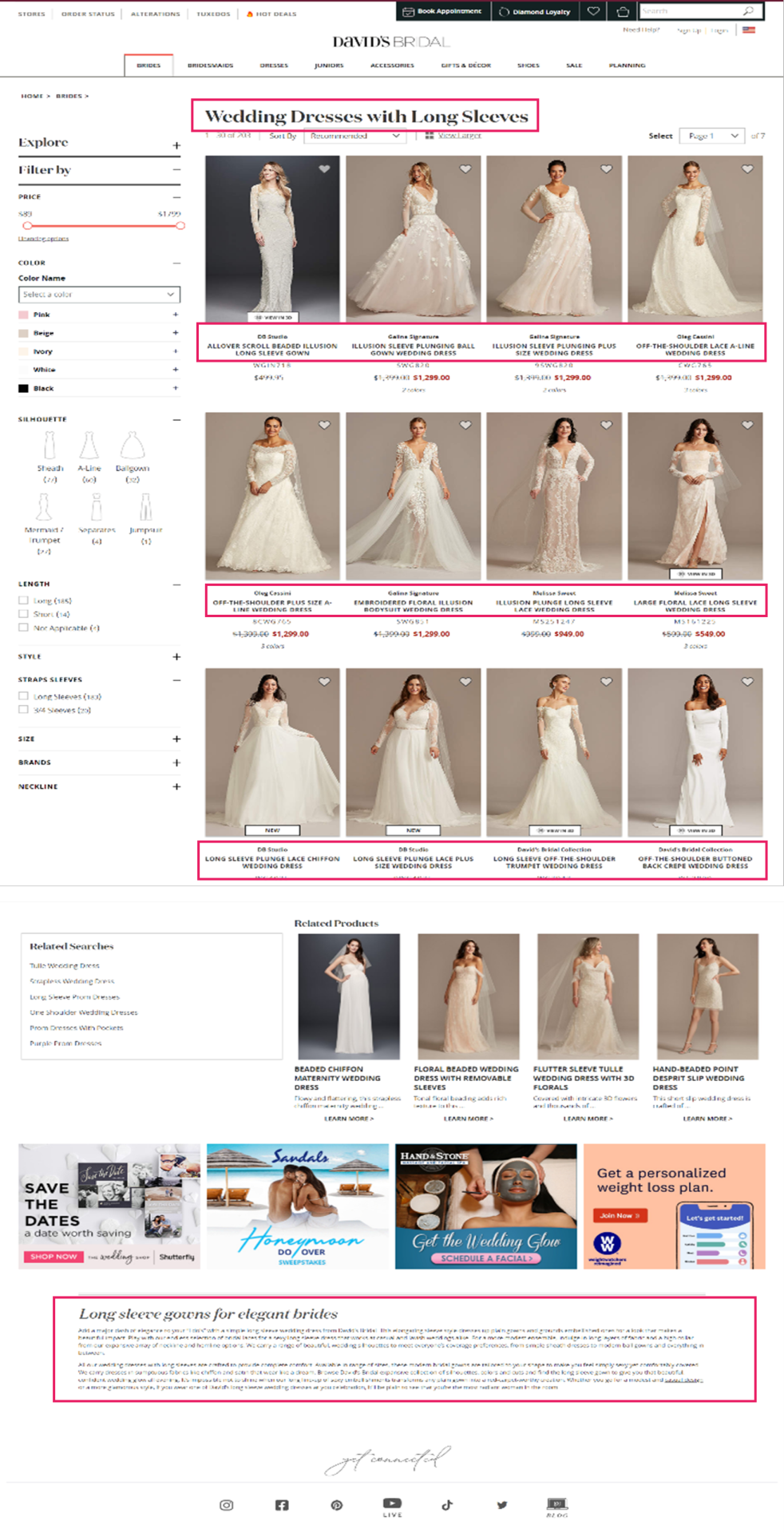
6. Provide accessibility and build page authority
Once you’ve opened up your new facet Product Listing Pages, you need to begin cultivating link equity towards them. This will ensure that they don’t exist as orphan URLs with no PageRank:
Ensure they’re referenced in your product XML sitemap.
If you have one feature per facet URL, then add them to your faceted navigation across CLP and Product Listing Page pages.
If you have two or more features per facet URL, then create a “Popular Searches” or “Related Searches” option within your CLPs.
Utilize your mega menu to showcase your new category landing pages. This will not only allow you to direct a large proportion of link equity, but it will also secure the highest click-through rate amongst your visitors.
Integrate your editorial strategy by creating engaging content with in-copy links. Think about how you can use descriptive long-tail anchor text about the Product Listing Page you want to link to rather than relying on “click here” or “see more”.
Connect to them via href links so you’re not solely relying on links from the main navigation or content hyperlinks. As this is difficult to do at scale, it can be done through modules such as “related categories”, “other subcategories”, “related products”, etc.
Devise strategic outreach campaigns that will secure quality, external backlinks to them.
Implementing this holistic and robust strategy will help you to secure exponential growth from your new commercial landing pages.
Conclusion
There is a great deal of organic opportunity that exists within your faceted navigation if you begin to leverage mid- and long-tail search terms.
Seek out the opportunity from extended keyword research and competitor analysis before deciding which variants fulfill consumer demands and deliver optimal organic sessions and onsite conversions. Configure a single faceted URL for each opportunity and open them up for crawl and indexation. Ensure PageRank is distributed to them (both internally and externally) and develop your landing page content in line with quality optimization practices. This approach will help you to avoid having crawl inefficiencies, over indexation, cannibalization, or having thin doorway pages. In turn, your website will be better suited to attract highly-targeted users and guide them down the purchase funnel.
Maximizing UX and reducing reliance on other marketing channels means that your faceted navigation can truly deliver organic ROI. We have seen this work for our clients.
0 notes
Text
Fulfill Untapped Customer Demands Through Your Faceted Navigation
Faceted navigation allows customers to narrow down search results based on specific product attributes. They typically exist on Product Listing Pages (PLPs) and are a great way to help users intuitively discover products but managing this filtering system is a common SEO challenge. Crawling and indexation need to be controlled.
However, if we look beyond their inherent functionality, facets can offer us considerable potential. By centering your secondary navigation on long-tail keyword opportunities, you’ll be able to strategically utilize consumer intent, secure additional web conversions, and boost revenue levels.
Match consumer intent with long-tail search queries
Having an established brand and a solid domain backlink profile won’t guarantee success. This is great news for smaller brands, as industry giants aren’t necessarily going to win at this game.
If we search for “long sleeve wedding dresses”, we can see how David’s Bridal’s optimized facet page (Domain Authority: 67/100, Page Authority: 47 / 100) has obtained the top ranking position, while Nordstrom’s result (Domain Authority: 87/100, Page Authority: 39/100) appears in the third position for this particular query. We’ll take a look at what makes this page so effective later.
When looking at how we can optimize faceted navigations, it’s important to recognize that product attributes convey consumer needs and aspirations. If, for example, I’m looking for a wedding dress, then I may tailor my search by the color, fabric, neckline shape, and the sleeve length.
According to the search demand curve, long-tail queries account for up to 70% of all organic searches. They are highly targeted queries that offer big traffic-driving opportunities.
In the last few years, we’ve seen a big shift in the industry towards capitalizing this intent with long-form content. Blog articles and style guides have become the go-to methods for many to capture these visitors, as we can see from the examples taken from Marks & Spencers’ "Inspire Me" section:

People often look for inspiration when they’re shopping, and these pages provide an effective way to add more internal links to category and product pages. But relying on this approach is one-dimensional, given that these deeper content pages tend to have lower PageRank. An extensive amount of time and effort will, therefore, be required to achieve the desired result.
In comparison, Product Listing Pages usually target broader search terms, and faceted navigations typically exist as passive functions. This is because they’re often blocked from crawlers, making them devoid of any SEO value. Waterstones (a well-known British bookstore) is one retailer that applies this rule for their on-page filters:
In this particular example, I’ve applied a filter to only show me books for 5 – 8 year olds, but the appended URL (https://ift.tt/3xrpOJS) is blocked in the robots.txt file. This is going to prevent such pages from being served in the SERPs despite them having the potential to meet specific customer needs. This shows that there can be a fundamental disconnect in matching customer intent to the pages we’re providing them in the organic results.
From the diagram below, we can see how editorial content typically focuses on the “awareness” and “interest” stages, whilst Product Listing Pages tend to be more in line with the “consideration” and “purchase” phases:
Serving the right content to users throughout their buying journey is pivotal to success. For many retailers, competitors are continuing to prioritize broader, high-volume keywords in saturated markets. They’re targeting the same terms to secure a proportion of the same search traffic. This is a very challenging prospect to face, and without carving out a gap in the marketplace, they won’t necessarily deliver the results they seek to secure. Likewise, relying on informational guides to target long-tail keywords means that you’re missing a large percentage of users who have very specific buying requirements. Yes, they’re ready to make a purchase!
By shifting your focus to address your customer’s real needs and expectations, you’ll be able to deliver a satisfying, frictionless experience at every interaction and all the way through to that final purchase.
The solution
Step 1: Conduct long-tail keyword research
Build a really comprehensive view of your potential customers by harnessing data from a variety of sources, including:
a) Keyword research tools like Moz, Google Keyword Planner, and Answer The Public.
b) The SERPs — get inspiration from the auto-suggest results, People Also Ask, and the related search links at the bottom of the page.
c) Competitor activity — aside from using SEO monitoring software, you can use a data mining extension tool like Scraper, which will extract faceted options directly from competitor Product Listing Pages. These tools are often free to download and allow you to quickly transfer product categories.
d) Your Google Search Console, Analytics, and PPC accounts to determine which keywords and URLs are securing the highest number of visits and web conversions. Internal search data can also give you great consumer insights.
e) Speak to your merchandising team to understand product demands and fulfillment capabilities.
Step 2: Group into meaningful sub-topics
Once you’ve collated all this information into a spreadsheet, you’ll be able to discover long-tail, consideration-orientated keywords. While individually they may not boast huge monthly search estimates, they can collectively highlight where purchase intentions can be better fulfilled.
To help illustrate this point, we can look at a small subset of lingerie keywords and the facets the searches represent:
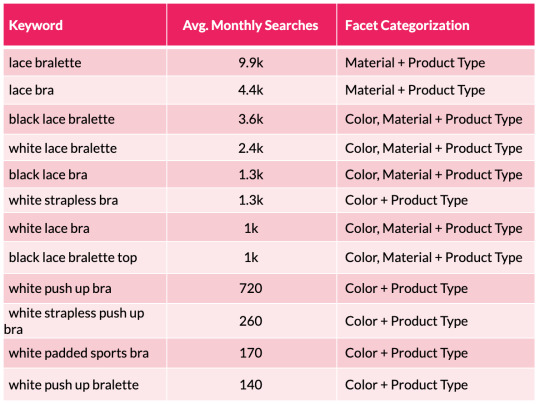
From the table above we can quickly see a pattern emerging with color and material variations appearing across the search terms. We can then substantiate this information with session and revenue estimates with the use of a recognized CTR model. This enables us to help forecast the potential organic uplift and quantify the size of the prize for a number of different scenarios that are on offer from each new facet combination. This may include estimations for securing position 10, 7, 5, 3 and 1 in Google.
One thing to note here is that it’s worth excluding synonyms, as they will falsely inflate your calculations. An example here would be to exclude “storage drawers” (22.2k monthly searchers) when reviewing the performance for “chest of drawers” (201k m/s). Including both variants will cause a false positive result and will lead you to draw incorrect conclusions.
Step 3: Dig deeper into broader terms around offers, ratings, and price
These product filters are found in the “Sort” dropdown box and, from my experience, these are set to “noindex” from the outset as they simply allow users to re-order page results. Certainly, content management systems like Shopify and Shopware have this as a default.
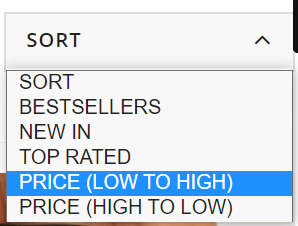
This makes sense since their purpose is to allow visitors to simply sort or narrow page content rather than offering alternative results and additional value (which is offered through faceted navigation). As such, filter typically produce duplicate results which should not be discoverable beyond the immediate moment. But this hard-and-fast rule doesn’t always apply perfectly in the real world. This is why we need to look at our individual industries and understand what’s important to our unique set of customers.
If we look at the world of gifting, we often see people shopping with a particular budget in mind. Therefore, terms like “birthday gift under £20” (40 m/s) or “Secret Santa gift under £10” (2.9k m/s) are reasonably common, and opening up relevant listing pages could be useful for shoppers.
Step 4: The technical steps
Facet taxonomies are hugely complex and the number of attributes that can be strung together increases with the size of the domain. We, therefore, need to carefully manage the flood gates and mitigate against any potential risks including crawl inefficiencies and link equity dilution.
We can do this by:
1. Avoiding thin/doorway pages by regularly re-assessing your product offering. For instance, you may consider there to be little value in creating a new listings page if you’re selling a very small range of low price point products. In this case, you may decide against opening up an additional Product Listing Page when you sell as few as 10 eligible products. However, this is not a fixed rule, so it’s quite possible that your criteria may be lower for particular product lines. Either way, these numbers will change over time. Consider seasonal trends, when new collections are launched, and when they become discontinued. Setting up a product retirement strategy to manage expired products and categories at scale in parallel with this step is also highly recommended.
2. Prevent content cannibalization by arranging selected facets according to their value and significance. “Size” is very important for some electrical goods like TVs, laptops, and cameras, but is less so for beauty accessories or vacuum cleaners. You must also make sure page content is distinctive and reflects the focus of your chosen facet(s). Refer to step 5 for more details.
3. Follow the sequence in which adjectives and facets are typically selected by your customers. This can vary depending on where your audience lives. So, whilst products generally have five or more distinguishable features, English vernacular determines that we use more than four adjectives (e.g. size + color + material + shape) to describe something.
4. Control the controllables by dealing with overlapping variations. This typically occurs when multiples co-exist and each exhibits good search metrics. For instance, it’s reasonable for someone to simultaneously look for several color and/or fabric combinations in the different ways below.

When this situation occurs, we should follow the same linguistic rules as above and choose a preferred sequence. In this case, it would be color + material + product type.
In comparison to the noindex tag suggested for on-page filters you should canonicalize unnecessary facets to their parent page (remembering that this is merely a hint and not a directive). This will enable you to control how crawlers deal with highly comparable result pages and will, therefore, help to prevent your site from being demoted in the SERPs. Dynamic search parameters should continue to be defined with a “noindex, nofollow” meta robots tag, disallowed in the robots.txt file, and configured through Google’s URL parameter tool (within your Search Console account) to tell crawlers the purpose of your parameters and how you would like them to be treated. This is a helpful guide on parameter handling for Googlebots, but bear in mind that this last tip won’t influence how Bing or Yahoo user-agents interpret these pages.
5. Open your facets in phases and cultivate it into a test-and-learn process. This will enable you to identify issues a lot sooner and implement facet-wide solutions in a timely manner. Without having to unravel these additional layers of complexity, problems such as crawl inefficiencies, PageRank dilution, or excessive indexation can be swiftly resolved.
To show you what this could look like, I’ve provided a phasing plan that was created for one of our e-commerce clients. Our research showed a significant SEO opportunity for opening up some of the facets and filters: potential +£263Kpcm for the “colour + type” facet (UK):
What’s more, when we extended our forecast to include other facet combinations, we calculated an additional revenue opportunity of up to +£207K/pcm (before filtering out combinations with no products offering).
Step 5: Optimize your facet URLs
Optimize your new facet category URLs to establish relevancy for your selected search terms. The key on-page elements to focus on include:
URL
Page title
Breadcrumb anchor texts
H tags
Content snippets (e.g. introductory text and FAQ copy)
Image ALT texts
Product names
Link out to similar facet category pages (i.e. via a “You May Also Like” feature box)
David’s Bridal is a good example of a retailer that has done this well. Looking back at the ‘Long Sleeve Wedding Dress’ Product Listing Page, we can see that they’ve curated unique content and followed fundamental optimization tactics on the landing page in a way that feels helpful to the user.
URL: davidsbridal.com/long-sleeve-wedding-dresses
Page Title: Long Sleeve Wedding Dresses & Gowns | David's Bridal
Meta Description: Do you dream of wearing a long sleeve wedding dress on your big day? Shop David's Bridal wide variety of wedding gowns with sleeves in lace & other designs!
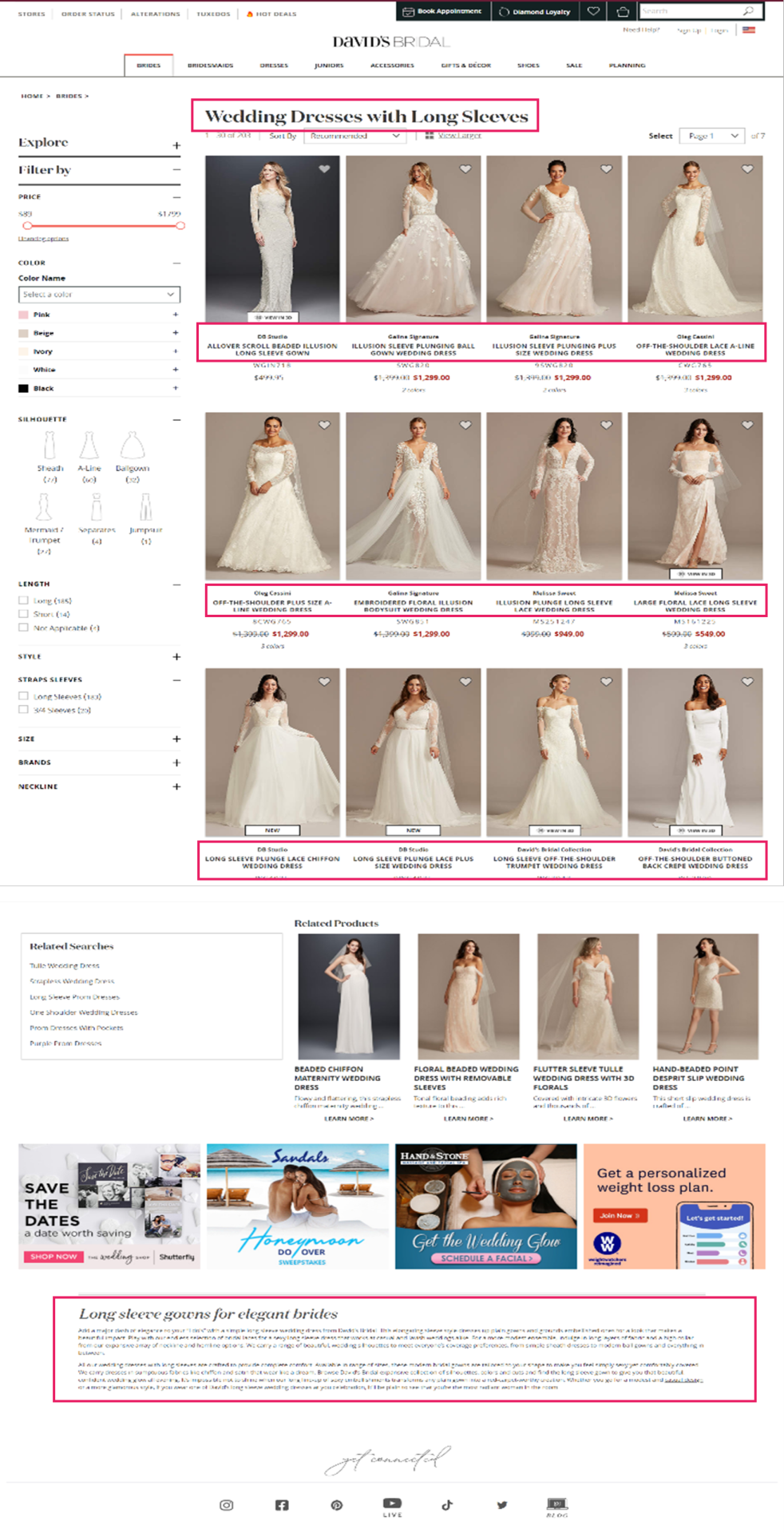
6. Provide accessibility and build page authority
Once you’ve opened up your new facet Product Listing Pages, you need to begin cultivating link equity towards them. This will ensure that they don’t exist as orphan URLs with no PageRank:
Ensure they’re referenced in your product XML sitemap.
If you have one feature per facet URL, then add them to your faceted navigation across CLP and Product Listing Page pages.
If you have two or more features per facet URL, then create a “Popular Searches” or “Related Searches” option within your CLPs.
Utilize your mega menu to showcase your new category landing pages. This will not only allow you to direct a large proportion of link equity, but it will also secure the highest click-through rate amongst your visitors.
Integrate your editorial strategy by creating engaging content with in-copy links. Think about how you can use descriptive long-tail anchor text about the Product Listing Page you want to link to rather than relying on “click here” or “see more”.
Connect to them via href links so you’re not solely relying on links from the main navigation or content hyperlinks. As this is difficult to do at scale, it can be done through modules such as “related categories”, “other subcategories”, “related products”, etc.
Devise strategic outreach campaigns that will secure quality, external backlinks to them.
Implementing this holistic and robust strategy will help you to secure exponential growth from your new commercial landing pages.
Conclusion
There is a great deal of organic opportunity that exists within your faceted navigation if you begin to leverage mid- and long-tail search terms.
Seek out the opportunity from extended keyword research and competitor analysis before deciding which variants fulfill consumer demands and deliver optimal organic sessions and onsite conversions. Configure a single faceted URL for each opportunity and open them up for crawl and indexation. Ensure PageRank is distributed to them (both internally and externally) and develop your landing page content in line with quality optimization practices. This approach will help you to avoid having crawl inefficiencies, over indexation, cannibalization, or having thin doorway pages. In turn, your website will be better suited to attract highly-targeted users and guide them down the purchase funnel.
Maximizing UX and reducing reliance on other marketing channels means that your faceted navigation can truly deliver organic ROI. We have seen this work for our clients.
0 notes
Text
Fulfill Untapped Customer Demands Through Your Faceted Navigation
Faceted navigation allows customers to narrow down search results based on specific product attributes. They typically exist on Product Listing Pages (PLPs) and are a great way to help users intuitively discover products but managing this filtering system is a common SEO challenge. Crawling and indexation need to be controlled.
However, if we look beyond their inherent functionality, facets can offer us considerable potential. By centering your secondary navigation on long-tail keyword opportunities, you’ll be able to strategically utilize consumer intent, secure additional web conversions, and boost revenue levels.
Match consumer intent with long-tail search queries
Having an established brand and a solid domain backlink profile won’t guarantee success. This is great news for smaller brands, as industry giants aren’t necessarily going to win at this game.
If we search for “long sleeve wedding dresses”, we can see how David’s Bridal’s optimized facet page (Domain Authority: 67/100, Page Authority: 47 / 100) has obtained the top ranking position, while Nordstrom’s result (Domain Authority: 87/100, Page Authority: 39/100) appears in the third position for this particular query. We’ll take a look at what makes this page so effective later.
When looking at how we can optimize faceted navigations, it’s important to recognize that product attributes convey consumer needs and aspirations. If, for example, I’m looking for a wedding dress, then I may tailor my search by the color, fabric, neckline shape, and the sleeve length.
According to the search demand curve, long-tail queries account for up to 70% of all organic searches. They are highly targeted queries that offer big traffic-driving opportunities.
In the last few years, we’ve seen a big shift in the industry towards capitalizing this intent with long-form content. Blog articles and style guides have become the go-to methods for many to capture these visitors, as we can see from the examples taken from Marks & Spencers’ "Inspire Me" section:

People often look for inspiration when they’re shopping, and these pages provide an effective way to add more internal links to category and product pages. But relying on this approach is one-dimensional, given that these deeper content pages tend to have lower PageRank. An extensive amount of time and effort will, therefore, be required to achieve the desired result.
In comparison, Product Listing Pages usually target broader search terms, and faceted navigations typically exist as passive functions. This is because they’re often blocked from crawlers, making them devoid of any SEO value. Waterstones (a well-known British bookstore) is one retailer that applies this rule for their on-page filters:
In this particular example, I’ve applied a filter to only show me books for 5 – 8 year olds, but the appended URL (https://ift.tt/3xrpOJS) is blocked in the robots.txt file. This is going to prevent such pages from being served in the SERPs despite them having the potential to meet specific customer needs. This shows that there can be a fundamental disconnect in matching customer intent to the pages we’re providing them in the organic results.
From the diagram below, we can see how editorial content typically focuses on the “awareness” and “interest” stages, whilst Product Listing Pages tend to be more in line with the “consideration” and “purchase” phases:
Serving the right content to users throughout their buying journey is pivotal to success. For many retailers, competitors are continuing to prioritize broader, high-volume keywords in saturated markets. They’re targeting the same terms to secure a proportion of the same search traffic. This is a very challenging prospect to face, and without carving out a gap in the marketplace, they won’t necessarily deliver the results they seek to secure. Likewise, relying on informational guides to target long-tail keywords means that you’re missing a large percentage of users who have very specific buying requirements. Yes, they’re ready to make a purchase!
By shifting your focus to address your customer’s real needs and expectations, you’ll be able to deliver a satisfying, frictionless experience at every interaction and all the way through to that final purchase.
The solution
Step 1: Conduct long-tail keyword research
Build a really comprehensive view of your potential customers by harnessing data from a variety of sources, including:
a) Keyword research tools like Moz, Google Keyword Planner, and Answer The Public.
b) The SERPs — get inspiration from the auto-suggest results, People Also Ask, and the related search links at the bottom of the page.
c) Competitor activity — aside from using SEO monitoring software, you can use a data mining extension tool like Scraper, which will extract faceted options directly from competitor Product Listing Pages. These tools are often free to download and allow you to quickly transfer product categories.
d) Your Google Search Console, Analytics, and PPC accounts to determine which keywords and URLs are securing the highest number of visits and web conversions. Internal search data can also give you great consumer insights.
e) Speak to your merchandising team to understand product demands and fulfillment capabilities.
Step 2: Group into meaningful sub-topics
Once you’ve collated all this information into a spreadsheet, you’ll be able to discover long-tail, consideration-orientated keywords. While individually they may not boast huge monthly search estimates, they can collectively highlight where purchase intentions can be better fulfilled.
To help illustrate this point, we can look at a small subset of lingerie keywords and the facets the searches represent:

From the table above we can quickly see a pattern emerging with color and material variations appearing across the search terms. We can then substantiate this information with session and revenue estimates with the use of a recognized CTR model. This enables us to help forecast the potential organic uplift and quantify the size of the prize for a number of different scenarios that are on offer from each new facet combination. This may include estimations for securing position 10, 7, 5, 3 and 1 in Google.
One thing to note here is that it’s worth excluding synonyms, as they will falsely inflate your calculations. An example here would be to exclude “storage drawers” (22.2k monthly searchers) when reviewing the performance for “chest of drawers” (201k m/s). Including both variants will cause a false positive result and will lead you to draw incorrect conclusions.
Step 3: Dig deeper into broader terms around offers, ratings, and price
These product filters are found in the “Sort” dropdown box and, from my experience, these are set to “noindex” from the outset as they simply allow users to re-order page results. Certainly, content management systems like Shopify and Shopware have this as a default.
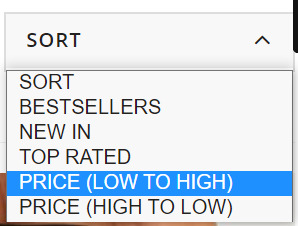
This makes sense since their purpose is to allow visitors to simply sort or narrow page content rather than offering alternative results and additional value (which is offered through faceted navigation). As such, filter typically produce duplicate results which should not be discoverable beyond the immediate moment. But this hard-and-fast rule doesn’t always apply perfectly in the real world. This is why we need to look at our individual industries and understand what’s important to our unique set of customers.
If we look at the world of gifting, we often see people shopping with a particular budget in mind. Therefore, terms like “birthday gift under £20” (40 m/s) or “Secret Santa gift under £10” (2.9k m/s) are reasonably common, and opening up relevant listing pages could be useful for shoppers.
Step 4: The technical steps
Facet taxonomies are hugely complex and the number of attributes that can be strung together increases with the size of the domain. We, therefore, need to carefully manage the flood gates and mitigate against any potential risks including crawl inefficiencies and link equity dilution.
We can do this by:
1. Avoiding thin/doorway pages by regularly re-assessing your product offering. For instance, you may consider there to be little value in creating a new listings page if you’re selling a very small range of low price point products. In this case, you may decide against opening up an additional Product Listing Page when you sell as few as 10 eligible products. However, this is not a fixed rule, so it’s quite possible that your criteria may be lower for particular product lines. Either way, these numbers will change over time. Consider seasonal trends, when new collections are launched, and when they become discontinued. Setting up a product retirement strategy to manage expired products and categories at scale in parallel with this step is also highly recommended.
2. Prevent content cannibalization by arranging selected facets according to their value and significance. “Size” is very important for some electrical goods like TVs, laptops, and cameras, but is less so for beauty accessories or vacuum cleaners. You must also make sure page content is distinctive and reflects the focus of your chosen facet(s). Refer to step 5 for more details.
3. Follow the sequence in which adjectives and facets are typically selected by your customers. This can vary depending on where your audience lives. So, whilst products generally have five or more distinguishable features, English vernacular determines that we use more than four adjectives (e.g. size + color + material + shape) to describe something.
4. Control the controllables by dealing with overlapping variations. This typically occurs when multiples co-exist and each exhibits good search metrics. For instance, it’s reasonable for someone to simultaneously look for several color and/or fabric combinations in the different ways below.

When this situation occurs, we should follow the same linguistic rules as above and choose a preferred sequence. In this case, it would be color + material + product type.
In comparison to the noindex tag suggested for on-page filters you should canonicalize unnecessary facets to their parent page (remembering that this is merely a hint and not a directive). This will enable you to control how crawlers deal with highly comparable result pages and will, therefore, help to prevent your site from being demoted in the SERPs. Dynamic search parameters should continue to be defined with a “noindex, nofollow” meta robots tag, disallowed in the robots.txt file, and configured through Google’s URL parameter tool (within your Search Console account) to tell crawlers the purpose of your parameters and how you would like them to be treated. This is a helpful guide on parameter handling for Googlebots, but bear in mind that this last tip won’t influence how Bing or Yahoo user-agents interpret these pages.
5. Open your facets in phases and cultivate it into a test-and-learn process. This will enable you to identify issues a lot sooner and implement facet-wide solutions in a timely manner. Without having to unravel these additional layers of complexity, problems such as crawl inefficiencies, PageRank dilution, or excessive indexation can be swiftly resolved.
To show you what this could look like, I’ve provided a phasing plan that was created for one of our e-commerce clients. Our research showed a significant SEO opportunity for opening up some of the facets and filters: potential +£263Kpcm for the “colour + type” facet (UK):
What’s more, when we extended our forecast to include other facet combinations, we calculated an additional revenue opportunity of up to +£207K/pcm (before filtering out combinations with no products offering).
Step 5: Optimize your facet URLs
Optimize your new facet category URLs to establish relevancy for your selected search terms. The key on-page elements to focus on include:
URL
Page title
Breadcrumb anchor texts
H tags
Content snippets (e.g. introductory text and FAQ copy)
Image ALT texts
Product names
Link out to similar facet category pages (i.e. via a “You May Also Like” feature box)
David’s Bridal is a good example of a retailer that has done this well. Looking back at the ‘Long Sleeve Wedding Dress’ Product Listing Page, we can see that they’ve curated unique content and followed fundamental optimization tactics on the landing page in a way that feels helpful to the user.
URL: davidsbridal.com/long-sleeve-wedding-dresses
Page Title: Long Sleeve Wedding Dresses & Gowns | David's Bridal
Meta Description: Do you dream of wearing a long sleeve wedding dress on your big day? Shop David's Bridal wide variety of wedding gowns with sleeves in lace & other designs!
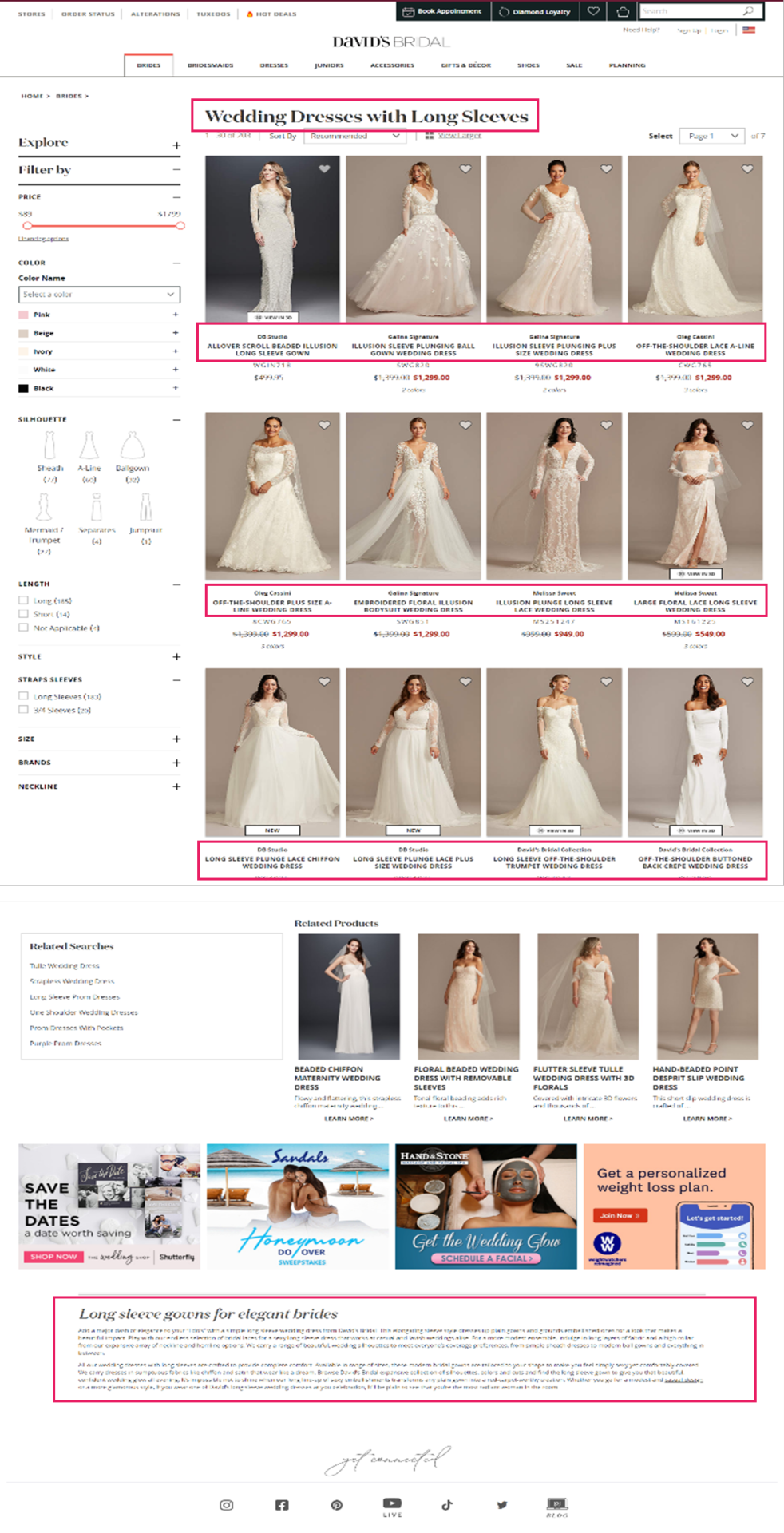
6. Provide accessibility and build page authority
Once you’ve opened up your new facet Product Listing Pages, you need to begin cultivating link equity towards them. This will ensure that they don’t exist as orphan URLs with no PageRank:
Ensure they’re referenced in your product XML sitemap.
If you have one feature per facet URL, then add them to your faceted navigation across CLP and Product Listing Page pages.
If you have two or more features per facet URL, then create a “Popular Searches” or “Related Searches” option within your CLPs.
Utilize your mega menu to showcase your new category landing pages. This will not only allow you to direct a large proportion of link equity, but it will also secure the highest click-through rate amongst your visitors.
Integrate your editorial strategy by creating engaging content with in-copy links. Think about how you can use descriptive long-tail anchor text about the Product Listing Page you want to link to rather than relying on “click here” or “see more”.
Connect to them via href links so you’re not solely relying on links from the main navigation or content hyperlinks. As this is difficult to do at scale, it can be done through modules such as “related categories”, “other subcategories”, “related products”, etc.
Devise strategic outreach campaigns that will secure quality, external backlinks to them.
Implementing this holistic and robust strategy will help you to secure exponential growth from your new commercial landing pages.
Conclusion
There is a great deal of organic opportunity that exists within your faceted navigation if you begin to leverage mid- and long-tail search terms.
Seek out the opportunity from extended keyword research and competitor analysis before deciding which variants fulfill consumer demands and deliver optimal organic sessions and onsite conversions. Configure a single faceted URL for each opportunity and open them up for crawl and indexation. Ensure PageRank is distributed to them (both internally and externally) and develop your landing page content in line with quality optimization practices. This approach will help you to avoid having crawl inefficiencies, over indexation, cannibalization, or having thin doorway pages. In turn, your website will be better suited to attract highly-targeted users and guide them down the purchase funnel.
Maximizing UX and reducing reliance on other marketing channels means that your faceted navigation can truly deliver organic ROI. We have seen this work for our clients.
#túi_giấy_epacking_việt_nam #túi_giấy_epacking #in_túi_giấy_giá_rẻ #in_túi_giấy #epackingvietnam #tuigiayepacking
0 notes
Text
Fulfill Untapped Customer Demands Through Your Faceted Navigation
Faceted navigation allows customers to narrow down search results based on specific product attributes. They typically exist on Product Listing Pages (PLPs) and are a great way to help users intuitively discover products but managing this filtering system is a common SEO challenge. Crawling and indexation need to be controlled.
However, if we look beyond their inherent functionality, facets can offer us considerable potential. By centering your secondary navigation on long-tail keyword opportunities, you’ll be able to strategically utilize consumer intent, secure additional web conversions, and boost revenue levels.
Match consumer intent with long-tail search queries
Having an established brand and a solid domain backlink profile won’t guarantee success. This is great news for smaller brands, as industry giants aren’t necessarily going to win at this game.
If we search for “long sleeve wedding dresses”, we can see how David’s Bridal’s optimized facet page (Domain Authority: 67/100, Page Authority: 47 / 100) has obtained the top ranking position, while Nordstrom’s result (Domain Authority: 87/100, Page Authority: 39/100) appears in the third position for this particular query. We’ll take a look at what makes this page so effective later.
When looking at how we can optimize faceted navigations, it’s important to recognize that product attributes convey consumer needs and aspirations. If, for example, I’m looking for a wedding dress, then I may tailor my search by the color, fabric, neckline shape, and the sleeve length.
According to the search demand curve, long-tail queries account for up to 70% of all organic searches. They are highly targeted queries that offer big traffic-driving opportunities.
In the last few years, we’ve seen a big shift in the industry towards capitalizing this intent with long-form content. Blog articles and style guides have become the go-to methods for many to capture these visitors, as we can see from the examples taken from Marks & Spencers’ "Inspire Me" section:
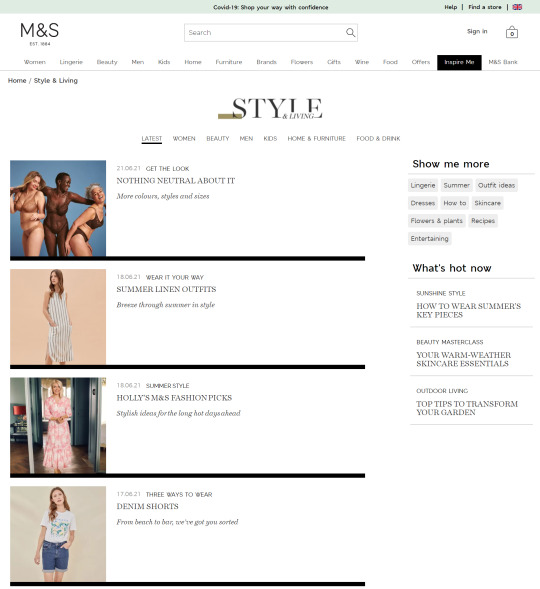
People often look for inspiration when they’re shopping, and these pages provide an effective way to add more internal links to category and product pages. But relying on this approach is one-dimensional, given that these deeper content pages tend to have lower PageRank. An extensive amount of time and effort will, therefore, be required to achieve the desired result.
In comparison, Product Listing Pages usually target broader search terms, and faceted navigations typically exist as passive functions. This is because they’re often blocked from crawlers, making them devoid of any SEO value. Waterstones (a well-known British bookstore) is one retailer that applies this rule for their on-page filters:
In this particular example, I’ve applied a filter to only show me books for 5 – 8 year olds, but the appended URL (https://www.waterstones.com/category/childrens-teenage/facet/498) is blocked in the robots.txt file. This is going to prevent such pages from being served in the SERPs despite them having the potential to meet specific customer needs. This shows that there can be a fundamental disconnect in matching customer intent to the pages we’re providing them in the organic results.
From the diagram below, we can see how editorial content typically focuses on the “awareness” and “interest” stages, whilst Product Listing Pages tend to be more in line with the “consideration” and “purchase” phases:
Serving the right content to users throughout their buying journey is pivotal to success. For many retailers, competitors are continuing to prioritize broader, high-volume keywords in saturated markets. They’re targeting the same terms to secure a proportion of the same search traffic. This is a very challenging prospect to face, and without carving out a gap in the marketplace, they won’t necessarily deliver the results they seek to secure. Likewise, relying on informational guides to target long-tail keywords means that you’re missing a large percentage of users who have very specific buying requirements. Yes, they’re ready to make a purchase!
By shifting your focus to address your customer’s real needs and expectations, you’ll be able to deliver a satisfying, frictionless experience at every interaction and all the way through to that final purchase.
The solution
Step 1: Conduct long-tail keyword research
Build a really comprehensive view of your potential customers by harnessing data from a variety of sources, including:
a) Keyword research tools like Moz, Google Keyword Planner, and Answer The Public.
b) The SERPs — get inspiration from the auto-suggest results, People Also Ask, and the related search links at the bottom of the page.
c) Competitor activity — aside from using SEO monitoring software, you can use a data mining extension tool like Scraper, which will extract faceted options directly from competitor Product Listing Pages. These tools are often free to download and allow you to quickly transfer product categories.
d) Your Google Search Console, Analytics, and PPC accounts to determine which keywords and URLs are securing the highest number of visits and web conversions. Internal search data can also give you great consumer insights.
e) Speak to your merchandising team to understand product demands and fulfillment capabilities.
Step 2: Group into meaningful sub-topics
Once you’ve collated all this information into a spreadsheet, you’ll be able to discover long-tail, consideration-orientated keywords. While individually they may not boast huge monthly search estimates, they can collectively highlight where purchase intentions can be better fulfilled.
To help illustrate this point, we can look at a small subset of lingerie keywords and the facets the searches represent:
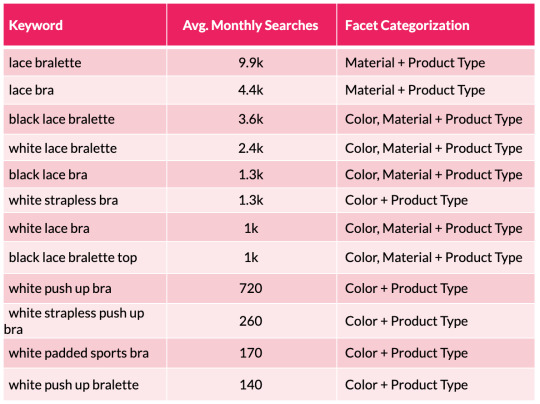
From the table above we can quickly see a pattern emerging with color and material variations appearing across the search terms. We can then substantiate this information with session and revenue estimates with the use of a recognized CTR model. This enables us to help forecast the potential organic uplift and quantify the size of the prize for a number of different scenarios that are on offer from each new facet combination. This may include estimations for securing position 10, 7, 5, 3 and 1 in Google.
One thing to note here is that it’s worth excluding synonyms, as they will falsely inflate your calculations. An example here would be to exclude “storage drawers” (22.2k monthly searchers) when reviewing the performance for “chest of drawers” (201k m/s). Including both variants will cause a false positive result and will lead you to draw incorrect conclusions.
Step 3: Dig deeper into broader terms around offers, ratings, and price
These product filters are found in the “Sort” dropdown box and, from my experience, these are set to “noindex” from the outset as they simply allow users to re-order page results. Certainly, content management systems like Shopify and Shopware have this as a default.
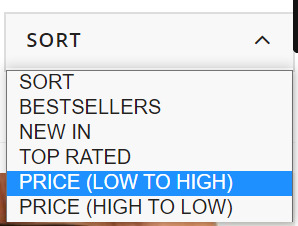
This makes sense since their purpose is to allow visitors to simply sort or narrow page content rather than offering alternative results and additional value (which is offered through faceted navigation). As such, filter typically produce duplicate results which should not be discoverable beyond the immediate moment. But this hard-and-fast rule doesn’t always apply perfectly in the real world. This is why we need to look at our individual industries and understand what’s important to our unique set of customers.
If we look at the world of gifting, we often see people shopping with a particular budget in mind. Therefore, terms like “birthday gift under £20” (40 m/s) or “Secret Santa gift under £10” (2.9k m/s) are reasonably common, and opening up relevant listing pages could be useful for shoppers.
Step 4: The technical steps
Facet taxonomies are hugely complex and the number of attributes that can be strung together increases with the size of the domain. We, therefore, need to carefully manage the flood gates and mitigate against any potential risks including crawl inefficiencies and link equity dilution.
We can do this by:
1. Avoiding thin/doorway pages by regularly re-assessing your product offering. For instance, you may consider there to be little value in creating a new listings page if you’re selling a very small range of low price point products. In this case, you may decide against opening up an additional Product Listing Page when you sell as few as 10 eligible products. However, this is not a fixed rule, so it’s quite possible that your criteria may be lower for particular product lines. Either way, these numbers will change over time. Consider seasonal trends, when new collections are launched, and when they become discontinued. Setting up a product retirement strategy to manage expired products and categories at scale in parallel with this step is also highly recommended.
2. Prevent content cannibalization by arranging selected facets according to their value and significance. “Size” is very important for some electrical goods like TVs, laptops, and cameras, but is less so for beauty accessories or vacuum cleaners. You must also make sure page content is distinctive and reflects the focus of your chosen facet(s). Refer to step 5 for more details.
3. Follow the sequence in which adjectives and facets are typically selected by your customers. This can vary depending on where your audience lives. So, whilst products generally have five or more distinguishable features, English vernacular determines that we use more than four adjectives (e.g. size + color + material + shape) to describe something.
4. Control the controllables by dealing with overlapping variations. This typically occurs when multiples co-exist and each exhibits good search metrics. For instance, it’s reasonable for someone to simultaneously look for several color and/or fabric combinations in the different ways below.
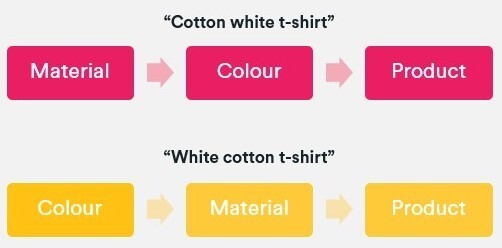
When this situation occurs, we should follow the same linguistic rules as above and choose a preferred sequence. In this case, it would be color + material + product type.
In comparison to the noindex tag suggested for on-page filters you should canonicalize unnecessary facets to their parent page (remembering that this is merely a hint and not a directive). This will enable you to control how crawlers deal with highly comparable result pages and will, therefore, help to prevent your site from being demoted in the SERPs. Dynamic search parameters should continue to be defined with a “noindex, nofollow” meta robots tag, disallowed in the robots.txt file, and configured through Google’s URL parameter tool (within your Search Console account) to tell crawlers the purpose of your parameters and how you would like them to be treated. This is a helpful guide on parameter handling for Googlebots, but bear in mind that this last tip won’t influence how Bing or Yahoo user-agents interpret these pages.
5. Open your facets in phases and cultivate it into a test-and-learn process. This will enable you to identify issues a lot sooner and implement facet-wide solutions in a timely manner. Without having to unravel these additional layers of complexity, problems such as crawl inefficiencies, PageRank dilution, or excessive indexation can be swiftly resolved.
To show you what this could look like, I’ve provided a phasing plan that was created for one of our e-commerce clients. Our research showed a significant SEO opportunity for opening up some of the facets and filters: potential +£263Kpcm for the “colour + type” facet (UK):
What’s more, when we extended our forecast to include other facet combinations, we calculated an additional revenue opportunity of up to +£207K/pcm (before filtering out combinations with no products offering).
Step 5: Optimize your facet URLs
Optimize your new facet category URLs to establish relevancy for your selected search terms. The key on-page elements to focus on include:
URL
Page title
Breadcrumb anchor texts
H tags
Content snippets (e.g. introductory text and FAQ copy)
Image ALT texts
Product names
Link out to similar facet category pages (i.e. via a “You May Also Like” feature box)
David’s Bridal is a good example of a retailer that has done this well. Looking back at the ‘Long Sleeve Wedding Dress’ Product Listing Page, we can see that they’ve curated unique content and followed fundamental optimization tactics on the landing page in a way that feels helpful to the user.
URL: davidsbridal.com/long-sleeve-wedding-dresses
Page Title: Long Sleeve Wedding Dresses & Gowns | David's Bridal
Meta Description: Do you dream of wearing a long sleeve wedding dress on your big day? Shop David's Bridal wide variety of wedding gowns with sleeves in lace & other designs!
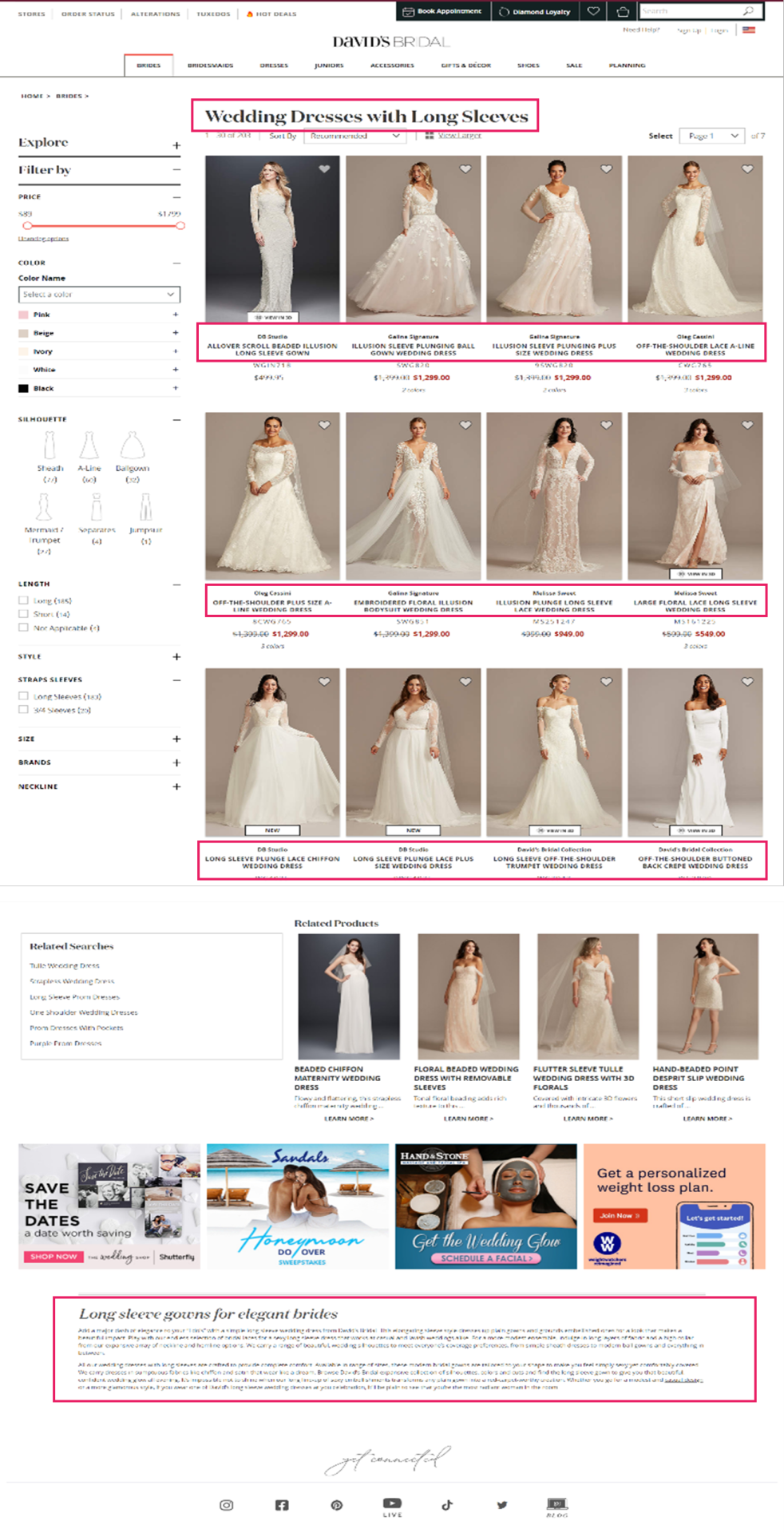
6. Provide accessibility and build page authority
Once you’ve opened up your new facet Product Listing Pages, you need to begin cultivating link equity towards them. This will ensure that they don’t exist as orphan URLs with no PageRank:
Ensure they’re referenced in your product XML sitemap.
If you have one feature per facet URL, then add them to your faceted navigation across CLP and Product Listing Page pages.
If you have two or more features per facet URL, then create a “Popular Searches” or “Related Searches” option within your CLPs.
Utilize your mega menu to showcase your new category landing pages. This will not only allow you to direct a large proportion of link equity, but it will also secure the highest click-through rate amongst your visitors.
Integrate your editorial strategy by creating engaging content with in-copy links. Think about how you can use descriptive long-tail anchor text about the Product Listing Page you want to link to rather than relying on “click here” or “see more”.
Connect to them via href links so you’re not solely relying on links from the main navigation or content hyperlinks. As this is difficult to do at scale, it can be done through modules such as “related categories”, “other subcategories”, “related products”, etc.
Devise strategic outreach campaigns that will secure quality, external backlinks to them.
Implementing this holistic and robust strategy will help you to secure exponential growth from your new commercial landing pages.
Conclusion
There is a great deal of organic opportunity that exists within your faceted navigation if you begin to leverage mid- and long-tail search terms.
Seek out the opportunity from extended keyword research and competitor analysis before deciding which variants fulfill consumer demands and deliver optimal organic sessions and onsite conversions. Configure a single faceted URL for each opportunity and open them up for crawl and indexation. Ensure PageRank is distributed to them (both internally and externally) and develop your landing page content in line with quality optimization practices. This approach will help you to avoid having crawl inefficiencies, over indexation, cannibalization, or having thin doorway pages. In turn, your website will be better suited to attract highly-targeted users and guide them down the purchase funnel.
Maximizing UX and reducing reliance on other marketing channels means that your faceted navigation can truly deliver organic ROI. We have seen this work for our clients.
0 notes
Text
Fulfill Untapped Customer Demands Through Your Faceted Navigation
Faceted navigation allows customers to narrow down search results based on specific product attributes. They typically exist on Product Listing Pages (PLPs) and are a great way to help users intuitively discover products but managing this filtering system is a common SEO challenge. Crawling and indexation need to be controlled.
However, if we look beyond their inherent functionality, facets can offer us considerable potential. By centering your secondary navigation on long-tail keyword opportunities, you’ll be able to strategically utilize consumer intent, secure additional web conversions, and boost revenue levels.
Match consumer intent with long-tail search queries
Having an established brand and a solid domain backlink profile won’t guarantee success. This is great news for smaller brands, as industry giants aren’t necessarily going to win at this game.
If we search for “long sleeve wedding dresses”, we can see how David’s Bridal’s optimized facet page (Domain Authority: 67/100, Page Authority: 47 / 100) has obtained the top ranking position, while Nordstrom’s result (Domain Authority: 87/100, Page Authority: 39/100) appears in the third position for this particular query. We’ll take a look at what makes this page so effective later.
When looking at how we can optimize faceted navigations, it’s important to recognize that product attributes convey consumer needs and aspirations. If, for example, I’m looking for a wedding dress, then I may tailor my search by the color, fabric, neckline shape, and the sleeve length.
According to the search demand curve, long-tail queries account for up to 70% of all organic searches. They are highly targeted queries that offer big traffic-driving opportunities.
In the last few years, we’ve seen a big shift in the industry towards capitalizing this intent with long-form content. Blog articles and style guides have become the go-to methods for many to capture these visitors, as we can see from the examples taken from Marks & Spencers’ "Inspire Me" section:

People often look for inspiration when they’re shopping, and these pages provide an effective way to add more internal links to category and product pages. But relying on this approach is one-dimensional, given that these deeper content pages tend to have lower PageRank. An extensive amount of time and effort will, therefore, be required to achieve the desired result.
In comparison, Product Listing Pages usually target broader search terms, and faceted navigations typically exist as passive functions. This is because they’re often blocked from crawlers, making them devoid of any SEO value. Waterstones (a well-known British bookstore) is one retailer that applies this rule for their on-page filters:
In this particular example, I’ve applied a filter to only show me books for 5 – 8 year olds, but the appended URL (https://bit.ly/2VccAT1) is blocked in the robots.txt file. This is going to prevent such pages from being served in the SERPs despite them having the potential to meet specific customer needs. This shows that there can be a fundamental disconnect in matching customer intent to the pages we’re providing them in the organic results.
From the diagram below, we can see how editorial content typically focuses on the “awareness” and “interest” stages, whilst Product Listing Pages tend to be more in line with the “consideration” and “purchase” phases:
Serving the right content to users throughout their buying journey is pivotal to success. For many retailers, competitors are continuing to prioritize broader, high-volume keywords in saturated markets. They’re targeting the same terms to secure a proportion of the same search traffic. This is a very challenging prospect to face, and without carving out a gap in the marketplace, they won’t necessarily deliver the results they seek to secure. Likewise, relying on informational guides to target long-tail keywords means that you’re missing a large percentage of users who have very specific buying requirements. Yes, they’re ready to make a purchase!
By shifting your focus to address your customer’s real needs and expectations, you’ll be able to deliver a satisfying, frictionless experience at every interaction and all the way through to that final purchase.
The solution
Step 1: Conduct long-tail keyword research
Build a really comprehensive view of your potential customers by harnessing data from a variety of sources, including:
a) Keyword research tools like Moz, Google Keyword Planner, and Answer The Public.
b) The SERPs — get inspiration from the auto-suggest results, People Also Ask, and the related search links at the bottom of the page.
c) Competitor activity — aside from using SEO monitoring software, you can use a data mining extension tool like Scraper, which will extract faceted options directly from competitor Product Listing Pages. These tools are often free to download and allow you to quickly transfer product categories.
d) Your Google Search Console, Analytics, and PPC accounts to determine which keywords and URLs are securing the highest number of visits and web conversions. Internal search data can also give you great consumer insights.
e) Speak to your merchandising team to understand product demands and fulfillment capabilities.
Step 2: Group into meaningful sub-topics
Once you’ve collated all this information into a spreadsheet, you’ll be able to discover long-tail, consideration-orientated keywords. While individually they may not boast huge monthly search estimates, they can collectively highlight where purchase intentions can be better fulfilled.
To help illustrate this point, we can look at a small subset of lingerie keywords and the facets the searches represent:

From the table above we can quickly see a pattern emerging with color and material variations appearing across the search terms. We can then substantiate this information with session and revenue estimates with the use of a recognized CTR model. This enables us to help forecast the potential organic uplift and quantify the size of the prize for a number of different scenarios that are on offer from each new facet combination. This may include estimations for securing position 10, 7, 5, 3 and 1 in Google.
One thing to note here is that it’s worth excluding synonyms, as they will falsely inflate your calculations. An example here would be to exclude “storage drawers” (22.2k monthly searchers) when reviewing the performance for “chest of drawers” (201k m/s). Including both variants will cause a false positive result and will lead you to draw incorrect conclusions.
Step 3: Dig deeper into broader terms around offers, ratings, and price
These product filters are found in the “Sort” dropdown box and, from my experience, these are set to “noindex” from the outset as they simply allow users to re-order page results. Certainly, content management systems like Shopify and Shopware have this as a default.
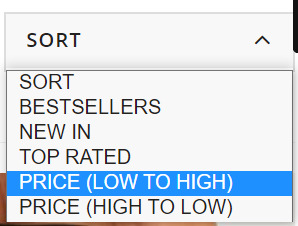
This makes sense since their purpose is to allow visitors to simply sort or narrow page content rather than offering alternative results and additional value (which is offered through faceted navigation). As such, filter typically produce duplicate results which should not be discoverable beyond the immediate moment. But this hard-and-fast rule doesn’t always apply perfectly in the real world. This is why we need to look at our individual industries and understand what’s important to our unique set of customers.
If we look at the world of gifting, we often see people shopping with a particular budget in mind. Therefore, terms like “birthday gift under £20” (40 m/s) or “Secret Santa gift under £10” (2.9k m/s) are reasonably common, and opening up relevant listing pages could be useful for shoppers.
Step 4: The technical steps
Facet taxonomies are hugely complex and the number of attributes that can be strung together increases with the size of the domain. We, therefore, need to carefully manage the flood gates and mitigate against any potential risks including crawl inefficiencies and link equity dilution.
We can do this by:
1. Avoiding thin/doorway pages by regularly re-assessing your product offering. For instance, you may consider there to be little value in creating a new listings page if you’re selling a very small range of low price point products. In this case, you may decide against opening up an additional Product Listing Page when you sell as few as 10 eligible products. However, this is not a fixed rule, so it’s quite possible that your criteria may be lower for particular product lines. Either way, these numbers will change over time. Consider seasonal trends, when new collections are launched, and when they become discontinued. Setting up a product retirement strategy to manage expired products and categories at scale in parallel with this step is also highly recommended.
2. Prevent content cannibalization by arranging selected facets according to their value and significance. “Size” is very important for some electrical goods like TVs, laptops, and cameras, but is less so for beauty accessories or vacuum cleaners. You must also make sure page content is distinctive and reflects the focus of your chosen facet(s). Refer to step 5 for more details.
3. Follow the sequence in which adjectives and facets are typically selected by your customers. This can vary depending on where your audience lives. So, whilst products generally have five or more distinguishable features, English vernacular determines that we use more than four adjectives (e.g. size + color + material + shape) to describe something.
4. Control the controllables by dealing with overlapping variations. This typically occurs when multiples co-exist and each exhibits good search metrics. For instance, it’s reasonable for someone to simultaneously look for several color and/or fabric combinations in the different ways below.

When this situation occurs, we should follow the same linguistic rules as above and choose a preferred sequence. In this case, it would be color + material + product type.
In comparison to the noindex tag suggested for on-page filters you should canonicalize unnecessary facets to their parent page (remembering that this is merely a hint and not a directive). This will enable you to control how crawlers deal with highly comparable result pages and will, therefore, help to prevent your site from being demoted in the SERPs. Dynamic search parameters should continue to be defined with a “noindex, nofollow” meta robots tag, disallowed in the robots.txt file, and configured through Google’s URL parameter tool (within your Search Console account) to tell crawlers the purpose of your parameters and how you would like them to be treated. This is a helpful guide on parameter handling for Googlebots, but bear in mind that this last tip won’t influence how Bing or Yahoo user-agents interpret these pages.
5. Open your facets in phases and cultivate it into a test-and-learn process. This will enable you to identify issues a lot sooner and implement facet-wide solutions in a timely manner. Without having to unravel these additional layers of complexity, problems such as crawl inefficiencies, PageRank dilution, or excessive indexation can be swiftly resolved.
To show you what this could look like, I’ve provided a phasing plan that was created for one of our e-commerce clients. Our research showed a significant SEO opportunity for opening up some of the facets and filters: potential +£263Kpcm for the “colour + type” facet (UK):
What’s more, when we extended our forecast to include other facet combinations, we calculated an additional revenue opportunity of up to +£207K/pcm (before filtering out combinations with no products offering).
Step 5: Optimize your facet URLs
Optimize your new facet category URLs to establish relevancy for your selected search terms. The key on-page elements to focus on include:
URL
Page title
Breadcrumb anchor texts
H tags
Content snippets (e.g. introductory text and FAQ copy)
Image ALT texts
Product names
Link out to similar facet category pages (i.e. via a “You May Also Like” feature box)
David’s Bridal is a good example of a retailer that has done this well. Looking back at the ‘Long Sleeve Wedding Dress’ Product Listing Page, we can see that they’ve curated unique content and followed fundamental optimization tactics on the landing page in a way that feels helpful to the user.
URL: davidsbridal.com/long-sleeve-wedding-dresses
Page Title: Long Sleeve Wedding Dresses & Gowns | David's Bridal
Meta Description: Do you dream of wearing a long sleeve wedding dress on your big day? Shop David's Bridal wide variety of wedding gowns with sleeves in lace & other designs!

6. Provide accessibility and build page authority
Once you’ve opened up your new facet Product Listing Pages, you need to begin cultivating link equity towards them. This will ensure that they don’t exist as orphan URLs with no PageRank:
Ensure they’re referenced in your product XML sitemap.
If you have one feature per facet URL, then add them to your faceted navigation across CLP and Product Listing Page pages.
If you have two or more features per facet URL, then create a “Popular Searches” or “Related Searches” option within your CLPs.
Utilize your mega menu to showcase your new category landing pages. This will not only allow you to direct a large proportion of link equity, but it will also secure the highest click-through rate amongst your visitors.
Integrate your editorial strategy by creating engaging content with in-copy links. Think about how you can use descriptive long-tail anchor text about the Product Listing Page you want to link to rather than relying on “click here” or “see more”.
Connect to them via href links so you’re not solely relying on links from the main navigation or content hyperlinks. As this is difficult to do at scale, it can be done through modules such as “related categories”, “other subcategories”, “related products”, etc.
Devise strategic outreach campaigns that will secure quality, external backlinks to them.
Implementing this holistic and robust strategy will help you to secure exponential growth from your new commercial landing pages.
Conclusion
There is a great deal of organic opportunity that exists within your faceted navigation if you begin to leverage mid- and long-tail search terms.
Seek out the opportunity from extended keyword research and competitor analysis before deciding which variants fulfill consumer demands and deliver optimal organic sessions and onsite conversions. Configure a single faceted URL for each opportunity and open them up for crawl and indexation. Ensure PageRank is distributed to them (both internally and externally) and develop your landing page content in line with quality optimization practices. This approach will help you to avoid having crawl inefficiencies, over indexation, cannibalization, or having thin doorway pages. In turn, your website will be better suited to attract highly-targeted users and guide them down the purchase funnel.
Maximizing UX and reducing reliance on other marketing channels means that your faceted navigation can truly deliver organic ROI. We have seen this work for our clients.
0 notes
Text
Fulfill Untapped Customer Demands Through Your Faceted Navigation
Faceted navigation allows customers to narrow down search results based on specific product attributes. They typically exist on Product Listing Pages (PLPs) and are a great way to help users intuitively discover products but managing this filtering system is a common SEO challenge. Crawling and indexation need to be controlled.
However, if we look beyond their inherent functionality, facets can offer us considerable potential. By centering your secondary navigation on long-tail keyword opportunities, you’ll be able to strategically utilize consumer intent, secure additional web conversions, and boost revenue levels.
Match consumer intent with long-tail search queries
Having an established brand and a solid domain backlink profile won’t guarantee success. This is great news for smaller brands, as industry giants aren’t necessarily going to win at this game.
If we search for “long sleeve wedding dresses”, we can see how David’s Bridal’s optimized facet page (Domain Authority: 67/100, Page Authority: 47 / 100) has obtained the top ranking position, while Nordstrom’s result (Domain Authority: 87/100, Page Authority: 39/100) appears in the third position for this particular query. We’ll take a look at what makes this page so effective later.
When looking at how we can optimize faceted navigations, it’s important to recognize that product attributes convey consumer needs and aspirations. If, for example, I’m looking for a wedding dress, then I may tailor my search by the color, fabric, neckline shape, and the sleeve length.
According to the search demand curve, long-tail queries account for up to 70% of all organic searches. They are highly targeted queries that offer big traffic-driving opportunities.
In the last few years, we’ve seen a big shift in the industry towards capitalizing this intent with long-form content. Blog articles and style guides have become the go-to methods for many to capture these visitors, as we can see from the examples taken from Marks & Spencers’ "Inspire Me" section:

People often look for inspiration when they’re shopping, and these pages provide an effective way to add more internal links to category and product pages. But relying on this approach is one-dimensional, given that these deeper content pages tend to have lower PageRank. An extensive amount of time and effort will, therefore, be required to achieve the desired result.
In comparison, Product Listing Pages usually target broader search terms, and faceted navigations typically exist as passive functions. This is because they’re often blocked from crawlers, making them devoid of any SEO value. Waterstones (a well-known British bookstore) is one retailer that applies this rule for their on-page filters:
In this particular example, I’ve applied a filter to only show me books for 5 – 8 year olds, but the appended URL (https://ift.tt/3xrpOJS) is blocked in the robots.txt file. This is going to prevent such pages from being served in the SERPs despite them having the potential to meet specific customer needs. This shows that there can be a fundamental disconnect in matching customer intent to the pages we’re providing them in the organic results.
From the diagram below, we can see how editorial content typically focuses on the “awareness” and “interest” stages, whilst Product Listing Pages tend to be more in line with the “consideration” and “purchase” phases:
Serving the right content to users throughout their buying journey is pivotal to success. For many retailers, competitors are continuing to prioritize broader, high-volume keywords in saturated markets. They’re targeting the same terms to secure a proportion of the same search traffic. This is a very challenging prospect to face, and without carving out a gap in the marketplace, they won’t necessarily deliver the results they seek to secure. Likewise, relying on informational guides to target long-tail keywords means that you’re missing a large percentage of users who have very specific buying requirements. Yes, they’re ready to make a purchase!
By shifting your focus to address your customer’s real needs and expectations, you’ll be able to deliver a satisfying, frictionless experience at every interaction and all the way through to that final purchase.
The solution
Step 1: Conduct long-tail keyword research
Build a really comprehensive view of your potential customers by harnessing data from a variety of sources, including:
a) Keyword research tools like Moz, Google Keyword Planner, and Answer The Public.
b) The SERPs — get inspiration from the auto-suggest results, People Also Ask, and the related search links at the bottom of the page.
c) Competitor activity — aside from using SEO monitoring software, you can use a data mining extension tool like Scraper, which will extract faceted options directly from competitor Product Listing Pages. These tools are often free to download and allow you to quickly transfer product categories.
d) Your Google Search Console, Analytics, and PPC accounts to determine which keywords and URLs are securing the highest number of visits and web conversions. Internal search data can also give you great consumer insights.
e) Speak to your merchandising team to understand product demands and fulfillment capabilities.
Step 2: Group into meaningful sub-topics
Once you’ve collated all this information into a spreadsheet, you’ll be able to discover long-tail, consideration-orientated keywords. While individually they may not boast huge monthly search estimates, they can collectively highlight where purchase intentions can be better fulfilled.
To help illustrate this point, we can look at a small subset of lingerie keywords and the facets the searches represent:
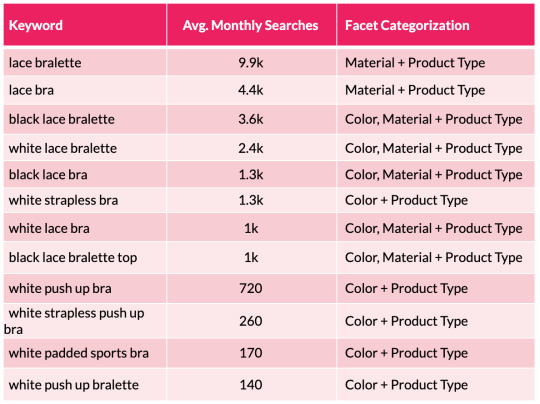
From the table above we can quickly see a pattern emerging with color and material variations appearing across the search terms. We can then substantiate this information with session and revenue estimates with the use of a recognized CTR model. This enables us to help forecast the potential organic uplift and quantify the size of the prize for a number of different scenarios that are on offer from each new facet combination. This may include estimations for securing position 10, 7, 5, 3 and 1 in Google.
One thing to note here is that it’s worth excluding synonyms, as they will falsely inflate your calculations. An example here would be to exclude “storage drawers” (22.2k monthly searchers) when reviewing the performance for “chest of drawers” (201k m/s). Including both variants will cause a false positive result and will lead you to draw incorrect conclusions.
Step 3: Dig deeper into broader terms around offers, ratings, and price
These product filters are found in the “Sort” dropdown box and, from my experience, these are set to “noindex” from the outset as they simply allow users to re-order page results. Certainly, content management systems like Shopify and Shopware have this as a default.

This makes sense since their purpose is to allow visitors to simply sort or narrow page content rather than offering alternative results and additional value (which is offered through faceted navigation). As such, filter typically produce duplicate results which should not be discoverable beyond the immediate moment. But this hard-and-fast rule doesn’t always apply perfectly in the real world. This is why we need to look at our individual industries and understand what’s important to our unique set of customers.
If we look at the world of gifting, we often see people shopping with a particular budget in mind. Therefore, terms like “birthday gift under £20” (40 m/s) or “Secret Santa gift under £10” (2.9k m/s) are reasonably common, and opening up relevant listing pages could be useful for shoppers.
Step 4: The technical steps
Facet taxonomies are hugely complex and the number of attributes that can be strung together increases with the size of the domain. We, therefore, need to carefully manage the flood gates and mitigate against any potential risks including crawl inefficiencies and link equity dilution.
We can do this by:
1. Avoiding thin/doorway pages by regularly re-assessing your product offering. For instance, you may consider there to be little value in creating a new listings page if you’re selling a very small range of low price point products. In this case, you may decide against opening up an additional Product Listing Page when you sell as few as 10 eligible products. However, this is not a fixed rule, so it’s quite possible that your criteria may be lower for particular product lines. Either way, these numbers will change over time. Consider seasonal trends, when new collections are launched, and when they become discontinued. Setting up a product retirement strategy to manage expired products and categories at scale in parallel with this step is also highly recommended.
2. Prevent content cannibalization by arranging selected facets according to their value and significance. “Size” is very important for some electrical goods like TVs, laptops, and cameras, but is less so for beauty accessories or vacuum cleaners. You must also make sure page content is distinctive and reflects the focus of your chosen facet(s). Refer to step 5 for more details.
3. Follow the sequence in which adjectives and facets are typically selected by your customers. This can vary depending on where your audience lives. So, whilst products generally have five or more distinguishable features, English vernacular determines that we use more than four adjectives (e.g. size + color + material + shape) to describe something.
4. Control the controllables by dealing with overlapping variations. This typically occurs when multiples co-exist and each exhibits good search metrics. For instance, it’s reasonable for someone to simultaneously look for several color and/or fabric combinations in the different ways below.
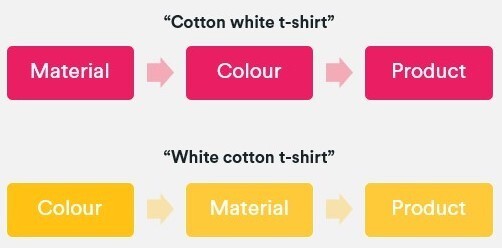
When this situation occurs, we should follow the same linguistic rules as above and choose a preferred sequence. In this case, it would be color + material + product type.
In comparison to the noindex tag suggested for on-page filters you should canonicalize unnecessary facets to their parent page (remembering that this is merely a hint and not a directive). This will enable you to control how crawlers deal with highly comparable result pages and will, therefore, help to prevent your site from being demoted in the SERPs. Dynamic search parameters should continue to be defined with a “noindex, nofollow” meta robots tag, disallowed in the robots.txt file, and configured through Google’s URL parameter tool (within your Search Console account) to tell crawlers the purpose of your parameters and how you would like them to be treated. This is a helpful guide on parameter handling for Googlebots, but bear in mind that this last tip won’t influence how Bing or Yahoo user-agents interpret these pages.
5. Open your facets in phases and cultivate it into a test-and-learn process. This will enable you to identify issues a lot sooner and implement facet-wide solutions in a timely manner. Without having to unravel these additional layers of complexity, problems such as crawl inefficiencies, PageRank dilution, or excessive indexation can be swiftly resolved.
To show you what this could look like, I’ve provided a phasing plan that was created for one of our e-commerce clients. Our research showed a significant SEO opportunity for opening up some of the facets and filters: potential +£263Kpcm for the “colour + type” facet (UK):
What’s more, when we extended our forecast to include other facet combinations, we calculated an additional revenue opportunity of up to +£207K/pcm (before filtering out combinations with no products offering).
Step 5: Optimize your facet URLs
Optimize your new facet category URLs to establish relevancy for your selected search terms. The key on-page elements to focus on include:
URL
Page title
Breadcrumb anchor texts
H tags
Content snippets (e.g. introductory text and FAQ copy)
Image ALT texts
Product names
Link out to similar facet category pages (i.e. via a “You May Also Like” feature box)
David’s Bridal is a good example of a retailer that has done this well. Looking back at the ‘Long Sleeve Wedding Dress’ Product Listing Page, we can see that they’ve curated unique content and followed fundamental optimization tactics on the landing page in a way that feels helpful to the user.
URL: davidsbridal.com/long-sleeve-wedding-dresses
Page Title: Long Sleeve Wedding Dresses & Gowns | David's Bridal
Meta Description: Do you dream of wearing a long sleeve wedding dress on your big day? Shop David's Bridal wide variety of wedding gowns with sleeves in lace & other designs!

6. Provide accessibility and build page authority
Once you’ve opened up your new facet Product Listing Pages, you need to begin cultivating link equity towards them. This will ensure that they don’t exist as orphan URLs with no PageRank:
Ensure they’re referenced in your product XML sitemap.
If you have one feature per facet URL, then add them to your faceted navigation across CLP and Product Listing Page pages.
If you have two or more features per facet URL, then create a “Popular Searches” or “Related Searches” option within your CLPs.
Utilize your mega menu to showcase your new category landing pages. This will not only allow you to direct a large proportion of link equity, but it will also secure the highest click-through rate amongst your visitors.
Integrate your editorial strategy by creating engaging content with in-copy links. Think about how you can use descriptive long-tail anchor text about the Product Listing Page you want to link to rather than relying on “click here” or “see more”.
Connect to them via href links so you’re not solely relying on links from the main navigation or content hyperlinks. As this is difficult to do at scale, it can be done through modules such as “related categories”, “other subcategories”, “related products”, etc.
Devise strategic outreach campaigns that will secure quality, external backlinks to them.
Implementing this holistic and robust strategy will help you to secure exponential growth from your new commercial landing pages.
Conclusion
There is a great deal of organic opportunity that exists within your faceted navigation if you begin to leverage mid- and long-tail search terms.
Seek out the opportunity from extended keyword research and competitor analysis before deciding which variants fulfill consumer demands and deliver optimal organic sessions and onsite conversions. Configure a single faceted URL for each opportunity and open them up for crawl and indexation. Ensure PageRank is distributed to them (both internally and externally) and develop your landing page content in line with quality optimization practices. This approach will help you to avoid having crawl inefficiencies, over indexation, cannibalization, or having thin doorway pages. In turn, your website will be better suited to attract highly-targeted users and guide them down the purchase funnel.
Maximizing UX and reducing reliance on other marketing channels means that your faceted navigation can truly deliver organic ROI. We have seen this work for our clients.
0 notes
Text
Fulfill Untapped Customer Demands Through Your Faceted Navigation
Faceted navigation allows customers to narrow down search results based on specific product attributes. They typically exist on Product Listing Pages (PLPs) and are a great way to help users intuitively discover products but managing this filtering system is a common SEO challenge. Crawling and indexation need to be controlled.
However, if we look beyond their inherent functionality, facets can offer us considerable potential. By centering your secondary navigation on long-tail keyword opportunities, you’ll be able to strategically utilize consumer intent, secure additional web conversions, and boost revenue levels.
Match consumer intent with long-tail search queries
Having an established brand and a solid domain backlink profile won’t guarantee success. This is great news for smaller brands, as industry giants aren’t necessarily going to win at this game.
If we search for “long sleeve wedding dresses”, we can see how David’s Bridal’s optimized facet page (Domain Authority: 67/100, Page Authority: 47 / 100) has obtained the top ranking position, while Nordstrom’s result (Domain Authority: 87/100, Page Authority: 39/100) appears in the third position for this particular query. We’ll take a look at what makes this page so effective later.
When looking at how we can optimize faceted navigations, it’s important to recognize that product attributes convey consumer needs and aspirations. If, for example, I’m looking for a wedding dress, then I may tailor my search by the color, fabric, neckline shape, and the sleeve length.
According to the search demand curve, long-tail queries account for up to 70% of all organic searches. They are highly targeted queries that offer big traffic-driving opportunities.
In the last few years, we’ve seen a big shift in the industry towards capitalizing this intent with long-form content. Blog articles and style guides have become the go-to methods for many to capture these visitors, as we can see from the examples taken from Marks & Spencers’ "Inspire Me" section:
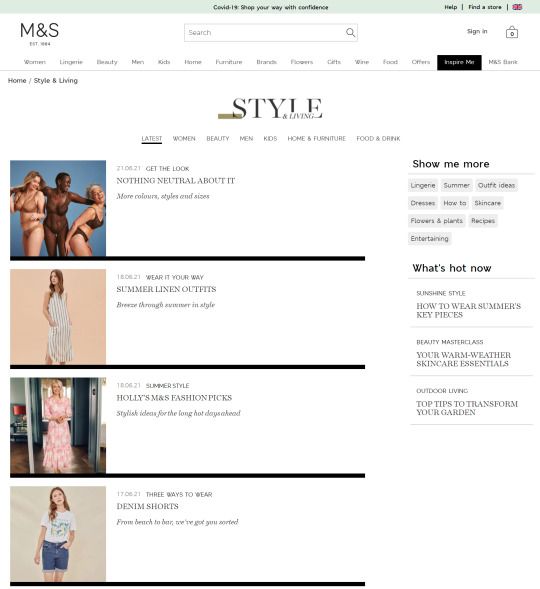
People often look for inspiration when they’re shopping, and these pages provide an effective way to add more internal links to category and product pages. But relying on this approach is one-dimensional, given that these deeper content pages tend to have lower PageRank. An extensive amount of time and effort will, therefore, be required to achieve the desired result.
In comparison, Product Listing Pages usually target broader search terms, and faceted navigations typically exist as passive functions. This is because they’re often blocked from crawlers, making them devoid of any SEO value. Waterstones (a well-known British bookstore) is one retailer that applies this rule for their on-page filters:
In this particular example, I’ve applied a filter to only show me books for 5 – 8 year olds, but the appended URL (https://ift.tt/3xrpOJS) is blocked in the robots.txt file. This is going to prevent such pages from being served in the SERPs despite them having the potential to meet specific customer needs. This shows that there can be a fundamental disconnect in matching customer intent to the pages we’re providing them in the organic results.
From the diagram below, we can see how editorial content typically focuses on the “awareness” and “interest” stages, whilst Product Listing Pages tend to be more in line with the “consideration” and “purchase” phases:
Serving the right content to users throughout their buying journey is pivotal to success. For many retailers, competitors are continuing to prioritize broader, high-volume keywords in saturated markets. They’re targeting the same terms to secure a proportion of the same search traffic. This is a very challenging prospect to face, and without carving out a gap in the marketplace, they won’t necessarily deliver the results they seek to secure. Likewise, relying on informational guides to target long-tail keywords means that you’re missing a large percentage of users who have very specific buying requirements. Yes, they’re ready to make a purchase!
By shifting your focus to address your customer’s real needs and expectations, you’ll be able to deliver a satisfying, frictionless experience at every interaction and all the way through to that final purchase.
The solution
Step 1: Conduct long-tail keyword research
Build a really comprehensive view of your potential customers by harnessing data from a variety of sources, including:
a) Keyword research tools like Moz, Google Keyword Planner, and Answer The Public.
b) The SERPs — get inspiration from the auto-suggest results, People Also Ask, and the related search links at the bottom of the page.
c) Competitor activity — aside from using SEO monitoring software, you can use a data mining extension tool like Scraper, which will extract faceted options directly from competitor Product Listing Pages. These tools are often free to download and allow you to quickly transfer product categories.
d) Your Google Search Console, Analytics, and PPC accounts to determine which keywords and URLs are securing the highest number of visits and web conversions. Internal search data can also give you great consumer insights.
e) Speak to your merchandising team to understand product demands and fulfillment capabilities.
Step 2: Group into meaningful sub-topics
Once you’ve collated all this information into a spreadsheet, you’ll be able to discover long-tail, consideration-orientated keywords. While individually they may not boast huge monthly search estimates, they can collectively highlight where purchase intentions can be better fulfilled.
To help illustrate this point, we can look at a small subset of lingerie keywords and the facets the searches represent:
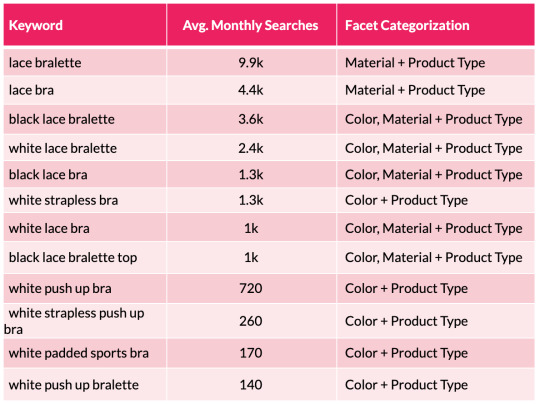
From the table above we can quickly see a pattern emerging with color and material variations appearing across the search terms. We can then substantiate this information with session and revenue estimates with the use of a recognized CTR model. This enables us to help forecast the potential organic uplift and quantify the size of the prize for a number of different scenarios that are on offer from each new facet combination. This may include estimations for securing position 10, 7, 5, 3 and 1 in Google.
One thing to note here is that it’s worth excluding synonyms, as they will falsely inflate your calculations. An example here would be to exclude “storage drawers” (22.2k monthly searchers) when reviewing the performance for “chest of drawers” (201k m/s). Including both variants will cause a false positive result and will lead you to draw incorrect conclusions.
Step 3: Dig deeper into broader terms around offers, ratings, and price
These product filters are found in the “Sort” dropdown box and, from my experience, these are set to “noindex” from the outset as they simply allow users to re-order page results. Certainly, content management systems like Shopify and Shopware have this as a default.
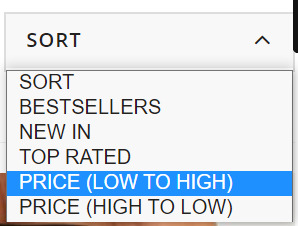
This makes sense since their purpose is to allow visitors to simply sort or narrow page content rather than offering alternative results and additional value (which is offered through faceted navigation). As such, filter typically produce duplicate results which should not be discoverable beyond the immediate moment. But this hard-and-fast rule doesn’t always apply perfectly in the real world. This is why we need to look at our individual industries and understand what’s important to our unique set of customers.
If we look at the world of gifting, we often see people shopping with a particular budget in mind. Therefore, terms like “birthday gift under £20” (40 m/s) or “Secret Santa gift under £10” (2.9k m/s) are reasonably common, and opening up relevant listing pages could be useful for shoppers.
Step 4: The technical steps
Facet taxonomies are hugely complex and the number of attributes that can be strung together increases with the size of the domain. We, therefore, need to carefully manage the flood gates and mitigate against any potential risks including crawl inefficiencies and link equity dilution.
We can do this by:
1. Avoiding thin/doorway pages by regularly re-assessing your product offering. For instance, you may consider there to be little value in creating a new listings page if you’re selling a very small range of low price point products. In this case, you may decide against opening up an additional Product Listing Page when you sell as few as 10 eligible products. However, this is not a fixed rule, so it’s quite possible that your criteria may be lower for particular product lines. Either way, these numbers will change over time. Consider seasonal trends, when new collections are launched, and when they become discontinued. Setting up a product retirement strategy to manage expired products and categories at scale in parallel with this step is also highly recommended.
2. Prevent content cannibalization by arranging selected facets according to their value and significance. “Size” is very important for some electrical goods like TVs, laptops, and cameras, but is less so for beauty accessories or vacuum cleaners. You must also make sure page content is distinctive and reflects the focus of your chosen facet(s). Refer to step 5 for more details.
3. Follow the sequence in which adjectives and facets are typically selected by your customers. This can vary depending on where your audience lives. So, whilst products generally have five or more distinguishable features, English vernacular determines that we use more than four adjectives (e.g. size + color + material + shape) to describe something.
4. Control the controllables by dealing with overlapping variations. This typically occurs when multiples co-exist and each exhibits good search metrics. For instance, it’s reasonable for someone to simultaneously look for several color and/or fabric combinations in the different ways below.
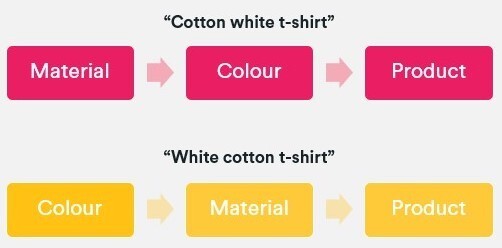
When this situation occurs, we should follow the same linguistic rules as above and choose a preferred sequence. In this case, it would be color + material + product type.
In comparison to the noindex tag suggested for on-page filters you should canonicalize unnecessary facets to their parent page (remembering that this is merely a hint and not a directive). This will enable you to control how crawlers deal with highly comparable result pages and will, therefore, help to prevent your site from being demoted in the SERPs. Dynamic search parameters should continue to be defined with a “noindex, nofollow” meta robots tag, disallowed in the robots.txt file, and configured through Google’s URL parameter tool (within your Search Console account) to tell crawlers the purpose of your parameters and how you would like them to be treated. This is a helpful guide on parameter handling for Googlebots, but bear in mind that this last tip won’t influence how Bing or Yahoo user-agents interpret these pages.
5. Open your facets in phases and cultivate it into a test-and-learn process. This will enable you to identify issues a lot sooner and implement facet-wide solutions in a timely manner. Without having to unravel these additional layers of complexity, problems such as crawl inefficiencies, PageRank dilution, or excessive indexation can be swiftly resolved.
To show you what this could look like, I’ve provided a phasing plan that was created for one of our e-commerce clients. Our research showed a significant SEO opportunity for opening up some of the facets and filters: potential +£263Kpcm for the “colour + type” facet (UK):
What’s more, when we extended our forecast to include other facet combinations, we calculated an additional revenue opportunity of up to +£207K/pcm (before filtering out combinations with no products offering).
Step 5: Optimize your facet URLs
Optimize your new facet category URLs to establish relevancy for your selected search terms. The key on-page elements to focus on include:
URL
Page title
Breadcrumb anchor texts
H tags
Content snippets (e.g. introductory text and FAQ copy)
Image ALT texts
Product names
Link out to similar facet category pages (i.e. via a “You May Also Like” feature box)
David’s Bridal is a good example of a retailer that has done this well. Looking back at the ‘Long Sleeve Wedding Dress’ Product Listing Page, we can see that they’ve curated unique content and followed fundamental optimization tactics on the landing page in a way that feels helpful to the user.
URL: davidsbridal.com/long-sleeve-wedding-dresses
Page Title: Long Sleeve Wedding Dresses & Gowns | David's Bridal
Meta Description: Do you dream of wearing a long sleeve wedding dress on your big day? Shop David's Bridal wide variety of wedding gowns with sleeves in lace & other designs!
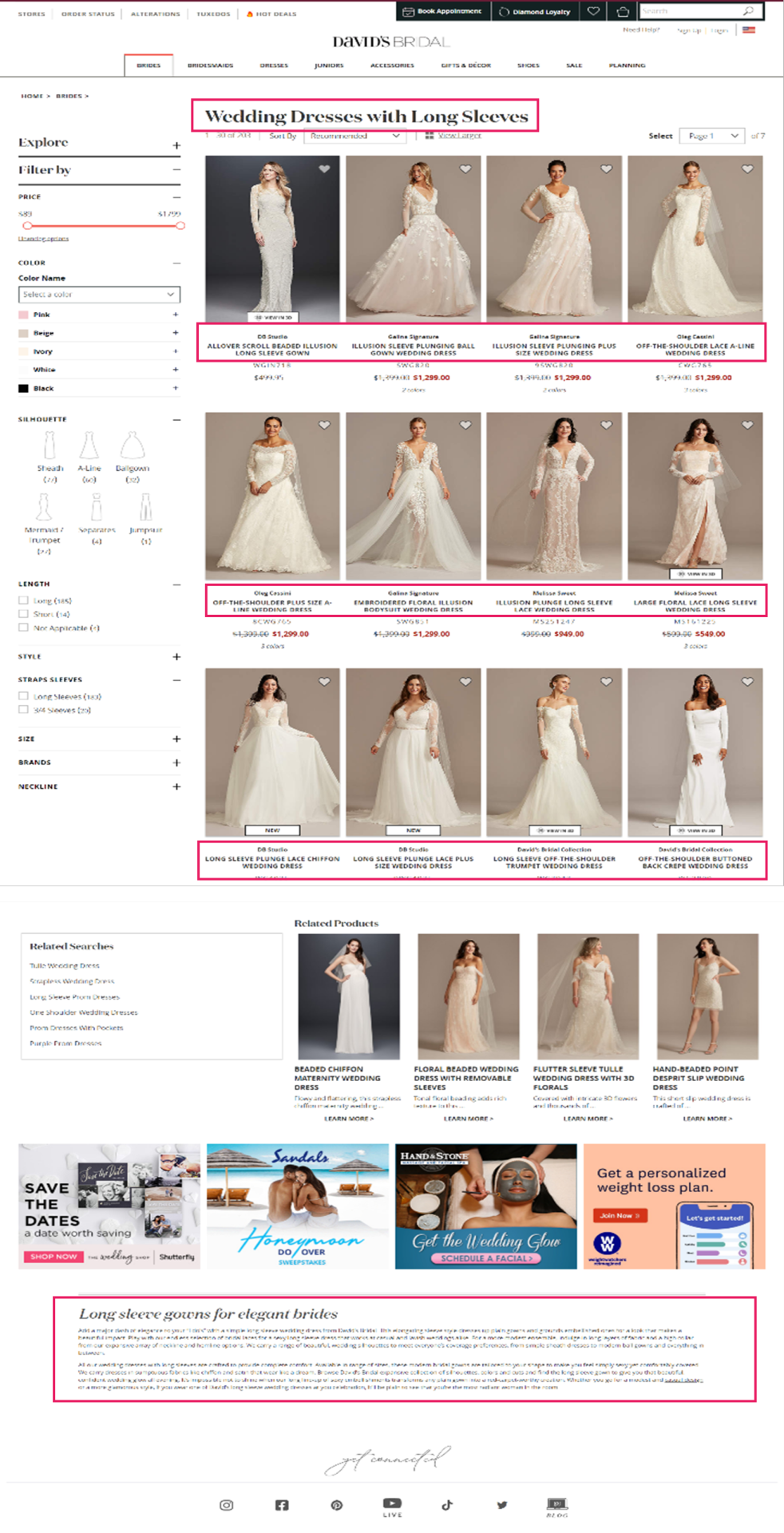
6. Provide accessibility and build page authority
Once you’ve opened up your new facet Product Listing Pages, you need to begin cultivating link equity towards them. This will ensure that they don’t exist as orphan URLs with no PageRank:
Ensure they’re referenced in your product XML sitemap.
If you have one feature per facet URL, then add them to your faceted navigation across CLP and Product Listing Page pages.
If you have two or more features per facet URL, then create a “Popular Searches” or “Related Searches” option within your CLPs.
Utilize your mega menu to showcase your new category landing pages. This will not only allow you to direct a large proportion of link equity, but it will also secure the highest click-through rate amongst your visitors.
Integrate your editorial strategy by creating engaging content with in-copy links. Think about how you can use descriptive long-tail anchor text about the Product Listing Page you want to link to rather than relying on “click here” or “see more”.
Connect to them via href links so you’re not solely relying on links from the main navigation or content hyperlinks. As this is difficult to do at scale, it can be done through modules such as “related categories”, “other subcategories”, “related products”, etc.
Devise strategic outreach campaigns that will secure quality, external backlinks to them.
Implementing this holistic and robust strategy will help you to secure exponential growth from your new commercial landing pages.
Conclusion
There is a great deal of organic opportunity that exists within your faceted navigation if you begin to leverage mid- and long-tail search terms.
Seek out the opportunity from extended keyword research and competitor analysis before deciding which variants fulfill consumer demands and deliver optimal organic sessions and onsite conversions. Configure a single faceted URL for each opportunity and open them up for crawl and indexation. Ensure PageRank is distributed to them (both internally and externally) and develop your landing page content in line with quality optimization practices. This approach will help you to avoid having crawl inefficiencies, over indexation, cannibalization, or having thin doorway pages. In turn, your website will be better suited to attract highly-targeted users and guide them down the purchase funnel.
Maximizing UX and reducing reliance on other marketing channels means that your faceted navigation can truly deliver organic ROI. We have seen this work for our clients.
0 notes
Text
Fulfill Untapped Customer Demands Through Your Faceted Navigation
Faceted navigation allows customers to narrow down search results based on specific product attributes. They typically exist on Product Listing Pages (PLPs) and are a great way to help users intuitively discover products but managing this filtering system is a common SEO challenge. Crawling and indexation need to be controlled.
However, if we look beyond their inherent functionality, facets can offer us considerable potential. By centering your secondary navigation on long-tail keyword opportunities, you’ll be able to strategically utilize consumer intent, secure additional web conversions, and boost revenue levels.
Match consumer intent with long-tail search queries
Having an established brand and a solid domain backlink profile won’t guarantee success. This is great news for smaller brands, as industry giants aren’t necessarily going to win at this game.
If we search for “long sleeve wedding dresses”, we can see how David’s Bridal’s optimized facet page (Domain Authority: 67/100, Page Authority: 47 / 100) has obtained the top ranking position, while Nordstrom’s result (Domain Authority: 87/100, Page Authority: 39/100) appears in the third position for this particular query. We’ll take a look at what makes this page so effective later.
When looking at how we can optimize faceted navigations, it’s important to recognize that product attributes convey consumer needs and aspirations. If, for example, I’m looking for a wedding dress, then I may tailor my search by the color, fabric, neckline shape, and the sleeve length.
According to the search demand curve, long-tail queries account for up to 70% of all organic searches. They are highly targeted queries that offer big traffic-driving opportunities.
In the last few years, we’ve seen a big shift in the industry towards capitalizing this intent with long-form content. Blog articles and style guides have become the go-to methods for many to capture these visitors, as we can see from the examples taken from Marks & Spencers’ "Inspire Me" section:
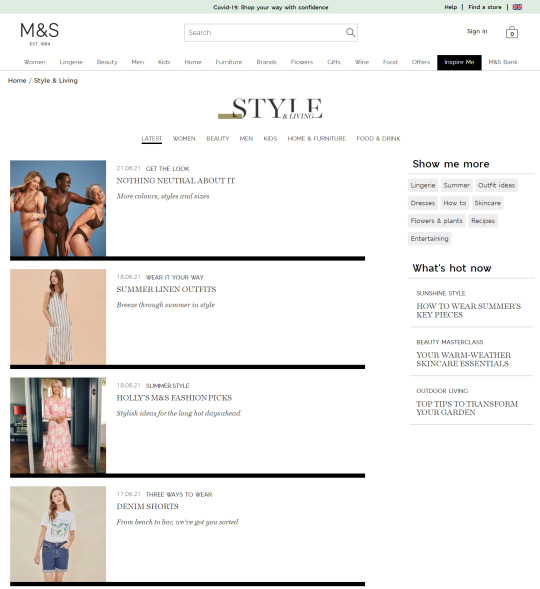
People often look for inspiration when they’re shopping, and these pages provide an effective way to add more internal links to category and product pages. But relying on this approach is one-dimensional, given that these deeper content pages tend to have lower PageRank. An extensive amount of time and effort will, therefore, be required to achieve the desired result.
In comparison, Product Listing Pages usually target broader search terms, and faceted navigations typically exist as passive functions. This is because they’re often blocked from crawlers, making them devoid of any SEO value. Waterstones (a well-known British bookstore) is one retailer that applies this rule for their on-page filters:
In this particular example, I’ve applied a filter to only show me books for 5 – 8 year olds, but the appended URL (https://ift.tt/3xrpOJS) is blocked in the robots.txt file. This is going to prevent such pages from being served in the SERPs despite them having the potential to meet specific customer needs. This shows that there can be a fundamental disconnect in matching customer intent to the pages we’re providing them in the organic results.
From the diagram below, we can see how editorial content typically focuses on the “awareness” and “interest” stages, whilst Product Listing Pages tend to be more in line with the “consideration” and “purchase” phases:
Serving the right content to users throughout their buying journey is pivotal to success. For many retailers, competitors are continuing to prioritize broader, high-volume keywords in saturated markets. They’re targeting the same terms to secure a proportion of the same search traffic. This is a very challenging prospect to face, and without carving out a gap in the marketplace, they won’t necessarily deliver the results they seek to secure. Likewise, relying on informational guides to target long-tail keywords means that you’re missing a large percentage of users who have very specific buying requirements. Yes, they’re ready to make a purchase!
By shifting your focus to address your customer’s real needs and expectations, you’ll be able to deliver a satisfying, frictionless experience at every interaction and all the way through to that final purchase.
The solution
Step 1: Conduct long-tail keyword research
Build a really comprehensive view of your potential customers by harnessing data from a variety of sources, including:
a) Keyword research tools like Moz, Google Keyword Planner, and Answer The Public.
b) The SERPs — get inspiration from the auto-suggest results, People Also Ask, and the related search links at the bottom of the page.
c) Competitor activity — aside from using SEO monitoring software, you can use a data mining extension tool like Scraper, which will extract faceted options directly from competitor Product Listing Pages. These tools are often free to download and allow you to quickly transfer product categories.
d) Your Google Search Console, Analytics, and PPC accounts to determine which keywords and URLs are securing the highest number of visits and web conversions. Internal search data can also give you great consumer insights.
e) Speak to your merchandising team to understand product demands and fulfillment capabilities.
Step 2: Group into meaningful sub-topics
Once you’ve collated all this information into a spreadsheet, you’ll be able to discover long-tail, consideration-orientated keywords. While individually they may not boast huge monthly search estimates, they can collectively highlight where purchase intentions can be better fulfilled.
To help illustrate this point, we can look at a small subset of lingerie keywords and the facets the searches represent:
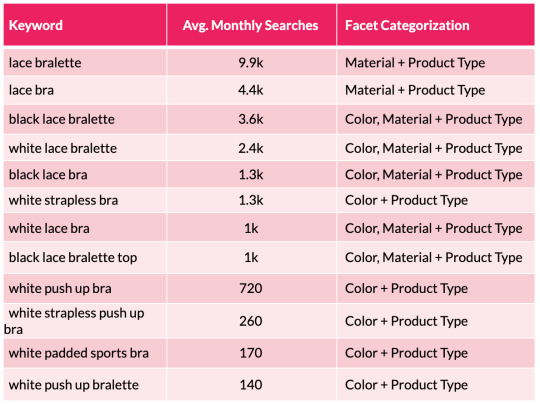
From the table above we can quickly see a pattern emerging with color and material variations appearing across the search terms. We can then substantiate this information with session and revenue estimates with the use of a recognized CTR model. This enables us to help forecast the potential organic uplift and quantify the size of the prize for a number of different scenarios that are on offer from each new facet combination. This may include estimations for securing position 10, 7, 5, 3 and 1 in Google.
One thing to note here is that it’s worth excluding synonyms, as they will falsely inflate your calculations. An example here would be to exclude “storage drawers” (22.2k monthly searchers) when reviewing the performance for “chest of drawers” (201k m/s). Including both variants will cause a false positive result and will lead you to draw incorrect conclusions.
Step 3: Dig deeper into broader terms around offers, ratings, and price
These product filters are found in the “Sort” dropdown box and, from my experience, these are set to “noindex” from the outset as they simply allow users to re-order page results. Certainly, content management systems like Shopify and Shopware have this as a default.

This makes sense since their purpose is to allow visitors to simply sort or narrow page content rather than offering alternative results and additional value (which is offered through faceted navigation). As such, filter typically produce duplicate results which should not be discoverable beyond the immediate moment. But this hard-and-fast rule doesn’t always apply perfectly in the real world. This is why we need to look at our individual industries and understand what’s important to our unique set of customers.
If we look at the world of gifting, we often see people shopping with a particular budget in mind. Therefore, terms like “birthday gift under £20” (40 m/s) or “Secret Santa gift under £10” (2.9k m/s) are reasonably common, and opening up relevant listing pages could be useful for shoppers.
Step 4: The technical steps
Facet taxonomies are hugely complex and the number of attributes that can be strung together increases with the size of the domain. We, therefore, need to carefully manage the flood gates and mitigate against any potential risks including crawl inefficiencies and link equity dilution.
We can do this by:
1. Avoiding thin/doorway pages by regularly re-assessing your product offering. For instance, you may consider there to be little value in creating a new listings page if you’re selling a very small range of low price point products. In this case, you may decide against opening up an additional Product Listing Page when you sell as few as 10 eligible products. However, this is not a fixed rule, so it’s quite possible that your criteria may be lower for particular product lines. Either way, these numbers will change over time. Consider seasonal trends, when new collections are launched, and when they become discontinued. Setting up a product retirement strategy to manage expired products and categories at scale in parallel with this step is also highly recommended.
2. Prevent content cannibalization by arranging selected facets according to their value and significance. “Size” is very important for some electrical goods like TVs, laptops, and cameras, but is less so for beauty accessories or vacuum cleaners. You must also make sure page content is distinctive and reflects the focus of your chosen facet(s). Refer to step 5 for more details.
3. Follow the sequence in which adjectives and facets are typically selected by your customers. This can vary depending on where your audience lives. So, whilst products generally have five or more distinguishable features, English vernacular determines that we use more than four adjectives (e.g. size + color + material + shape) to describe something.
4. Control the controllables by dealing with overlapping variations. This typically occurs when multiples co-exist and each exhibits good search metrics. For instance, it’s reasonable for someone to simultaneously look for several color and/or fabric combinations in the different ways below.

When this situation occurs, we should follow the same linguistic rules as above and choose a preferred sequence. In this case, it would be color + material + product type.
In comparison to the noindex tag suggested for on-page filters you should canonicalize unnecessary facets to their parent page (remembering that this is merely a hint and not a directive). This will enable you to control how crawlers deal with highly comparable result pages and will, therefore, help to prevent your site from being demoted in the SERPs. Dynamic search parameters should continue to be defined with a “noindex, nofollow” meta robots tag, disallowed in the robots.txt file, and configured through Google’s URL parameter tool (within your Search Console account) to tell crawlers the purpose of your parameters and how you would like them to be treated. This is a helpful guide on parameter handling for Googlebots, but bear in mind that this last tip won’t influence how Bing or Yahoo user-agents interpret these pages.
5. Open your facets in phases and cultivate it into a test-and-learn process. This will enable you to identify issues a lot sooner and implement facet-wide solutions in a timely manner. Without having to unravel these additional layers of complexity, problems such as crawl inefficiencies, PageRank dilution, or excessive indexation can be swiftly resolved.
To show you what this could look like, I’ve provided a phasing plan that was created for one of our e-commerce clients. Our research showed a significant SEO opportunity for opening up some of the facets and filters: potential +£263Kpcm for the “colour + type” facet (UK):
What’s more, when we extended our forecast to include other facet combinations, we calculated an additional revenue opportunity of up to +£207K/pcm (before filtering out combinations with no products offering).
Step 5: Optimize your facet URLs
Optimize your new facet category URLs to establish relevancy for your selected search terms. The key on-page elements to focus on include:
URL
Page title
Breadcrumb anchor texts
H tags
Content snippets (e.g. introductory text and FAQ copy)
Image ALT texts
Product names
Link out to similar facet category pages (i.e. via a “You May Also Like” feature box)
David’s Bridal is a good example of a retailer that has done this well. Looking back at the ‘Long Sleeve Wedding Dress’ Product Listing Page, we can see that they’ve curated unique content and followed fundamental optimization tactics on the landing page in a way that feels helpful to the user.
URL: davidsbridal.com/long-sleeve-wedding-dresses
Page Title: Long Sleeve Wedding Dresses & Gowns | David's Bridal
Meta Description: Do you dream of wearing a long sleeve wedding dress on your big day? Shop David's Bridal wide variety of wedding gowns with sleeves in lace & other designs!

6. Provide accessibility and build page authority
Once you’ve opened up your new facet Product Listing Pages, you need to begin cultivating link equity towards them. This will ensure that they don’t exist as orphan URLs with no PageRank:
Ensure they’re referenced in your product XML sitemap.
If you have one feature per facet URL, then add them to your faceted navigation across CLP and Product Listing Page pages.
If you have two or more features per facet URL, then create a “Popular Searches” or “Related Searches” option within your CLPs.
Utilize your mega menu to showcase your new category landing pages. This will not only allow you to direct a large proportion of link equity, but it will also secure the highest click-through rate amongst your visitors.
Integrate your editorial strategy by creating engaging content with in-copy links. Think about how you can use descriptive long-tail anchor text about the Product Listing Page you want to link to rather than relying on “click here” or “see more”.
Connect to them via href links so you’re not solely relying on links from the main navigation or content hyperlinks. As this is difficult to do at scale, it can be done through modules such as “related categories”, “other subcategories”, “related products”, etc.
Devise strategic outreach campaigns that will secure quality, external backlinks to them.
Implementing this holistic and robust strategy will help you to secure exponential growth from your new commercial landing pages.
Conclusion
There is a great deal of organic opportunity that exists within your faceted navigation if you begin to leverage mid- and long-tail search terms.
Seek out the opportunity from extended keyword research and competitor analysis before deciding which variants fulfill consumer demands and deliver optimal organic sessions and onsite conversions. Configure a single faceted URL for each opportunity and open them up for crawl and indexation. Ensure PageRank is distributed to them (both internally and externally) and develop your landing page content in line with quality optimization practices. This approach will help you to avoid having crawl inefficiencies, over indexation, cannibalization, or having thin doorway pages. In turn, your website will be better suited to attract highly-targeted users and guide them down the purchase funnel.
Maximizing UX and reducing reliance on other marketing channels means that your faceted navigation can truly deliver organic ROI. We have seen this work for our clients.
0 notes
Text
Fulfill Untapped Customer Demands Through Your Faceted Navigation
Faceted navigation allows customers to narrow down search results based on specific product attributes. They typically exist on Product Listing Pages (PLPs) and are a great way to help users intuitively discover products but managing this filtering system is a common SEO challenge. Crawling and indexation need to be controlled.
However, if we look beyond their inherent functionality, facets can offer us considerable potential. By centering your secondary navigation on long-tail keyword opportunities, you’ll be able to strategically utilize consumer intent, secure additional web conversions, and boost revenue levels.
Match consumer intent with long-tail search queries
Having an established brand and a solid domain backlink profile won’t guarantee success. This is great news for smaller brands, as industry giants aren’t necessarily going to win at this game.
If we search for “long sleeve wedding dresses”, we can see how David’s Bridal’s optimized facet page (Domain Authority: 67/100, Page Authority: 47 / 100) has obtained the top ranking position, while Nordstrom’s result (Domain Authority: 87/100, Page Authority: 39/100) appears in the third position for this particular query. We’ll take a look at what makes this page so effective later.
When looking at how we can optimize faceted navigations, it’s important to recognize that product attributes convey consumer needs and aspirations. If, for example, I’m looking for a wedding dress, then I may tailor my search by the color, fabric, neckline shape, and the sleeve length.
According to the search demand curve, long-tail queries account for up to 70% of all organic searches. They are highly targeted queries that offer big traffic-driving opportunities.
In the last few years, we’ve seen a big shift in the industry towards capitalizing this intent with long-form content. Blog articles and style guides have become the go-to methods for many to capture these visitors, as we can see from the examples taken from Marks & Spencers’ "Inspire Me" section:
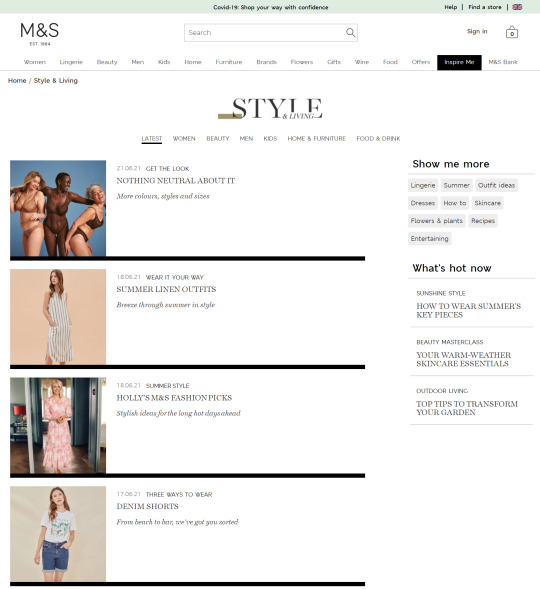
People often look for inspiration when they’re shopping, and these pages provide an effective way to add more internal links to category and product pages. But relying on this approach is one-dimensional, given that these deeper content pages tend to have lower PageRank. An extensive amount of time and effort will, therefore, be required to achieve the desired result.
In comparison, Product Listing Pages usually target broader search terms, and faceted navigations typically exist as passive functions. This is because they’re often blocked from crawlers, making them devoid of any SEO value. Waterstones (a well-known British bookstore) is one retailer that applies this rule for their on-page filters:
In this particular example, I’ve applied a filter to only show me books for 5 – 8 year olds, but the appended URL (https://ift.tt/3xrpOJS) is blocked in the robots.txt file. This is going to prevent such pages from being served in the SERPs despite them having the potential to meet specific customer needs. This shows that there can be a fundamental disconnect in matching customer intent to the pages we’re providing them in the organic results.
From the diagram below, we can see how editorial content typically focuses on the “awareness” and “interest” stages, whilst Product Listing Pages tend to be more in line with the “consideration” and “purchase” phases:
Serving the right content to users throughout their buying journey is pivotal to success. For many retailers, competitors are continuing to prioritize broader, high-volume keywords in saturated markets. They’re targeting the same terms to secure a proportion of the same search traffic. This is a very challenging prospect to face, and without carving out a gap in the marketplace, they won’t necessarily deliver the results they seek to secure. Likewise, relying on informational guides to target long-tail keywords means that you’re missing a large percentage of users who have very specific buying requirements. Yes, they’re ready to make a purchase!
By shifting your focus to address your customer’s real needs and expectations, you’ll be able to deliver a satisfying, frictionless experience at every interaction and all the way through to that final purchase.
The solution
Step 1: Conduct long-tail keyword research
Build a really comprehensive view of your potential customers by harnessing data from a variety of sources, including:
a) Keyword research tools like Moz, Google Keyword Planner, and Answer The Public.
b) The SERPs — get inspiration from the auto-suggest results, People Also Ask, and the related search links at the bottom of the page.
c) Competitor activity — aside from using SEO monitoring software, you can use a data mining extension tool like Scraper, which will extract faceted options directly from competitor Product Listing Pages. These tools are often free to download and allow you to quickly transfer product categories.
d) Your Google Search Console, Analytics, and PPC accounts to determine which keywords and URLs are securing the highest number of visits and web conversions. Internal search data can also give you great consumer insights.
e) Speak to your merchandising team to understand product demands and fulfillment capabilities.
Step 2: Group into meaningful sub-topics
Once you’ve collated all this information into a spreadsheet, you’ll be able to discover long-tail, consideration-orientated keywords. While individually they may not boast huge monthly search estimates, they can collectively highlight where purchase intentions can be better fulfilled.
To help illustrate this point, we can look at a small subset of lingerie keywords and the facets the searches represent:

From the table above we can quickly see a pattern emerging with color and material variations appearing across the search terms. We can then substantiate this information with session and revenue estimates with the use of a recognized CTR model. This enables us to help forecast the potential organic uplift and quantify the size of the prize for a number of different scenarios that are on offer from each new facet combination. This may include estimations for securing position 10, 7, 5, 3 and 1 in Google.
One thing to note here is that it’s worth excluding synonyms, as they will falsely inflate your calculations. An example here would be to exclude “storage drawers” (22.2k monthly searchers) when reviewing the performance for “chest of drawers” (201k m/s). Including both variants will cause a false positive result and will lead you to draw incorrect conclusions.
Step 3: Dig deeper into broader terms around offers, ratings, and price
These product filters are found in the “Sort” dropdown box and, from my experience, these are set to “noindex” from the outset as they simply allow users to re-order page results. Certainly, content management systems like Shopify and Shopware have this as a default.

This makes sense since their purpose is to allow visitors to simply sort or narrow page content rather than offering alternative results and additional value (which is offered through faceted navigation). As such, filter typically produce duplicate results which should not be discoverable beyond the immediate moment. But this hard-and-fast rule doesn’t always apply perfectly in the real world. This is why we need to look at our individual industries and understand what’s important to our unique set of customers.
If we look at the world of gifting, we often see people shopping with a particular budget in mind. Therefore, terms like “birthday gift under £20” (40 m/s) or “Secret Santa gift under £10” (2.9k m/s) are reasonably common, and opening up relevant listing pages could be useful for shoppers.
Step 4: The technical steps
Facet taxonomies are hugely complex and the number of attributes that can be strung together increases with the size of the domain. We, therefore, need to carefully manage the flood gates and mitigate against any potential risks including crawl inefficiencies and link equity dilution.
We can do this by:
1. Avoiding thin/doorway pages by regularly re-assessing your product offering. For instance, you may consider there to be little value in creating a new listings page if you’re selling a very small range of low price point products. In this case, you may decide against opening up an additional Product Listing Page when you sell as few as 10 eligible products. However, this is not a fixed rule, so it’s quite possible that your criteria may be lower for particular product lines. Either way, these numbers will change over time. Consider seasonal trends, when new collections are launched, and when they become discontinued. Setting up a product retirement strategy to manage expired products and categories at scale in parallel with this step is also highly recommended.
2. Prevent content cannibalization by arranging selected facets according to their value and significance. “Size” is very important for some electrical goods like TVs, laptops, and cameras, but is less so for beauty accessories or vacuum cleaners. You must also make sure page content is distinctive and reflects the focus of your chosen facet(s). Refer to step 5 for more details.
3. Follow the sequence in which adjectives and facets are typically selected by your customers. This can vary depending on where your audience lives. So, whilst products generally have five or more distinguishable features, English vernacular determines that we use more than four adjectives (e.g. size + color + material + shape) to describe something.
4. Control the controllables by dealing with overlapping variations. This typically occurs when multiples co-exist and each exhibits good search metrics. For instance, it’s reasonable for someone to simultaneously look for several color and/or fabric combinations in the different ways below.
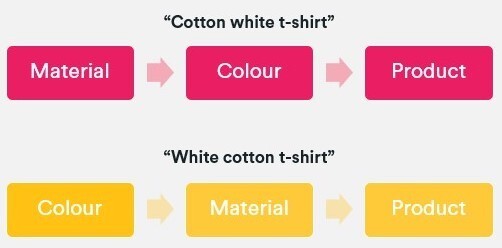
When this situation occurs, we should follow the same linguistic rules as above and choose a preferred sequence. In this case, it would be color + material + product type.
In comparison to the noindex tag suggested for on-page filters you should canonicalize unnecessary facets to their parent page (remembering that this is merely a hint and not a directive). This will enable you to control how crawlers deal with highly comparable result pages and will, therefore, help to prevent your site from being demoted in the SERPs. Dynamic search parameters should continue to be defined with a “noindex, nofollow” meta robots tag, disallowed in the robots.txt file, and configured through Google’s URL parameter tool (within your Search Console account) to tell crawlers the purpose of your parameters and how you would like them to be treated. This is a helpful guide on parameter handling for Googlebots, but bear in mind that this last tip won’t influence how Bing or Yahoo user-agents interpret these pages.
5. Open your facets in phases and cultivate it into a test-and-learn process. This will enable you to identify issues a lot sooner and implement facet-wide solutions in a timely manner. Without having to unravel these additional layers of complexity, problems such as crawl inefficiencies, PageRank dilution, or excessive indexation can be swiftly resolved.
To show you what this could look like, I’ve provided a phasing plan that was created for one of our e-commerce clients. Our research showed a significant SEO opportunity for opening up some of the facets and filters: potential +£263Kpcm for the “colour + type” facet (UK):
What’s more, when we extended our forecast to include other facet combinations, we calculated an additional revenue opportunity of up to +£207K/pcm (before filtering out combinations with no products offering).
Step 5: Optimize your facet URLs
Optimize your new facet category URLs to establish relevancy for your selected search terms. The key on-page elements to focus on include:
URL
Page title
Breadcrumb anchor texts
H tags
Content snippets (e.g. introductory text and FAQ copy)
Image ALT texts
Product names
Link out to similar facet category pages (i.e. via a “You May Also Like” feature box)
David’s Bridal is a good example of a retailer that has done this well. Looking back at the ‘Long Sleeve Wedding Dress’ Product Listing Page, we can see that they’ve curated unique content and followed fundamental optimization tactics on the landing page in a way that feels helpful to the user.
URL: davidsbridal.com/long-sleeve-wedding-dresses
Page Title: Long Sleeve Wedding Dresses & Gowns | David's Bridal
Meta Description: Do you dream of wearing a long sleeve wedding dress on your big day? Shop David's Bridal wide variety of wedding gowns with sleeves in lace & other designs!

6. Provide accessibility and build page authority
Once you’ve opened up your new facet Product Listing Pages, you need to begin cultivating link equity towards them. This will ensure that they don’t exist as orphan URLs with no PageRank:
Ensure they’re referenced in your product XML sitemap.
If you have one feature per facet URL, then add them to your faceted navigation across CLP and Product Listing Page pages.
If you have two or more features per facet URL, then create a “Popular Searches” or “Related Searches” option within your CLPs.
Utilize your mega menu to showcase your new category landing pages. This will not only allow you to direct a large proportion of link equity, but it will also secure the highest click-through rate amongst your visitors.
Integrate your editorial strategy by creating engaging content with in-copy links. Think about how you can use descriptive long-tail anchor text about the Product Listing Page you want to link to rather than relying on “click here” or “see more”.
Connect to them via href links so you’re not solely relying on links from the main navigation or content hyperlinks. As this is difficult to do at scale, it can be done through modules such as “related categories”, “other subcategories”, “related products”, etc.
Devise strategic outreach campaigns that will secure quality, external backlinks to them.
Implementing this holistic and robust strategy will help you to secure exponential growth from your new commercial landing pages.
Conclusion
There is a great deal of organic opportunity that exists within your faceted navigation if you begin to leverage mid- and long-tail search terms.
Seek out the opportunity from extended keyword research and competitor analysis before deciding which variants fulfill consumer demands and deliver optimal organic sessions and onsite conversions. Configure a single faceted URL for each opportunity and open them up for crawl and indexation. Ensure PageRank is distributed to them (both internally and externally) and develop your landing page content in line with quality optimization practices. This approach will help you to avoid having crawl inefficiencies, over indexation, cannibalization, or having thin doorway pages. In turn, your website will be better suited to attract highly-targeted users and guide them down the purchase funnel.
Maximizing UX and reducing reliance on other marketing channels means that your faceted navigation can truly deliver organic ROI. We have seen this work for our clients.
https://ift.tt/3qUUr85
0 notes
Text
Fulfill Untapped Customer Demands Through Your Faceted Navigation
Faceted navigation allows customers to narrow down search results based on specific product attributes. They typically exist on Product Listing Pages (PLPs) and are a great way to help users intuitively discover products but managing this filtering system is a common SEO challenge. Crawling and indexation need to be controlled.
However, if we look beyond their inherent functionality, facets can offer us considerable potential. By centering your secondary navigation on long-tail keyword opportunities, you’ll be able to strategically utilize consumer intent, secure additional web conversions, and boost revenue levels.
Match consumer intent with long-tail search queries
Having an established brand and a solid domain backlink profile won’t guarantee success. This is great news for smaller brands, as industry giants aren’t necessarily going to win at this game.
If we search for “long sleeve wedding dresses”, we can see how David’s Bridal’s optimized facet page (Domain Authority: 67/100, Page Authority: 47 / 100) has obtained the top ranking position, while Nordstrom’s result (Domain Authority: 87/100, Page Authority: 39/100) appears in the third position for this particular query. We’ll take a look at what makes this page so effective later.
When looking at how we can optimize faceted navigations, it’s important to recognize that product attributes convey consumer needs and aspirations. If, for example, I’m looking for a wedding dress, then I may tailor my search by the color, fabric, neckline shape, and the sleeve length.
According to the search demand curve, long-tail queries account for up to 70% of all organic searches. They are highly targeted queries that offer big traffic-driving opportunities.
In the last few years, we’ve seen a big shift in the industry towards capitalizing this intent with long-form content. Blog articles and style guides have become the go-to methods for many to capture these visitors, as we can see from the examples taken from Marks & Spencers’ "Inspire Me" section:
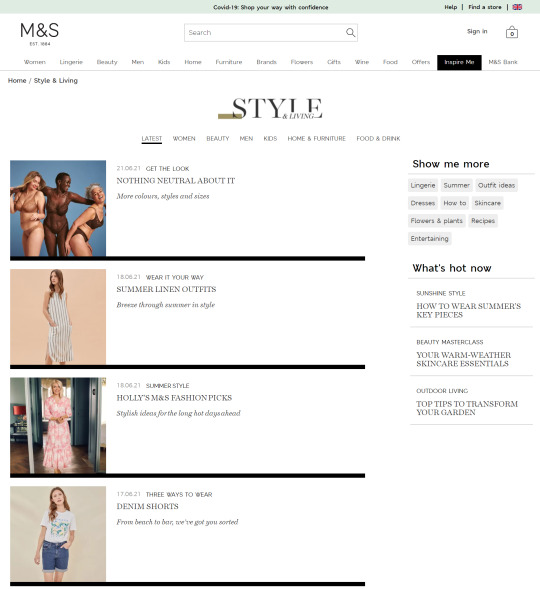
People often look for inspiration when they’re shopping, and these pages provide an effective way to add more internal links to category and product pages. But relying on this approach is one-dimensional, given that these deeper content pages tend to have lower PageRank. An extensive amount of time and effort will, therefore, be required to achieve the desired result.
In comparison, Product Listing Pages usually target broader search terms, and faceted navigations typically exist as passive functions. This is because they’re often blocked from crawlers, making them devoid of any SEO value. Waterstones (a well-known British bookstore) is one retailer that applies this rule for their on-page filters:
In this particular example, I’ve applied a filter to only show me books for 5 – 8 year olds, but the appended URL (https://www.waterstones.com/category/childrens-teenage/facet/498) is blocked in the robots.txt file. This is going to prevent such pages from being served in the SERPs despite them having the potential to meet specific customer needs. This shows that there can be a fundamental disconnect in matching customer intent to the pages we’re providing them in the organic results.
From the diagram below, we can see how editorial content typically focuses on the “awareness” and “interest” stages, whilst Product Listing Pages tend to be more in line with the “consideration” and “purchase” phases:
Serving the right content to users throughout their buying journey is pivotal to success. For many retailers, competitors are continuing to prioritize broader, high-volume keywords in saturated markets. They’re targeting the same terms to secure a proportion of the same search traffic. This is a very challenging prospect to face, and without carving out a gap in the marketplace, they won’t necessarily deliver the results they seek to secure. Likewise, relying on informational guides to target long-tail keywords means that you’re missing a large percentage of users who have very specific buying requirements. Yes, they’re ready to make a purchase!
By shifting your focus to address your customer’s real needs and expectations, you’ll be able to deliver a satisfying, frictionless experience at every interaction and all the way through to that final purchase.
The solution
Step 1: Conduct long-tail keyword research
Build a really comprehensive view of your potential customers by harnessing data from a variety of sources, including:
a) Keyword research tools like Moz, Google Keyword Planner, and Answer The Public.
b) The SERPs — get inspiration from the auto-suggest results, People Also Ask, and the related search links at the bottom of the page.
c) Competitor activity — aside from using SEO monitoring software, you can use a data mining extension tool like Scraper, which will extract faceted options directly from competitor Product Listing Pages. These tools are often free to download and allow you to quickly transfer product categories.
d) Your Google Search Console, Analytics, and PPC accounts to determine which keywords and URLs are securing the highest number of visits and web conversions. Internal search data can also give you great consumer insights.
e) Speak to your merchandising team to understand product demands and fulfillment capabilities.
Step 2: Group into meaningful sub-topics
Once you’ve collated all this information into a spreadsheet, you’ll be able to discover long-tail, consideration-orientated keywords. While individually they may not boast huge monthly search estimates, they can collectively highlight where purchase intentions can be better fulfilled.
To help illustrate this point, we can look at a small subset of lingerie keywords and the facets the searches represent:

From the table above we can quickly see a pattern emerging with color and material variations appearing across the search terms. We can then substantiate this information with session and revenue estimates with the use of a recognized CTR model. This enables us to help forecast the potential organic uplift and quantify the size of the prize for a number of different scenarios that are on offer from each new facet combination. This may include estimations for securing position 10, 7, 5, 3 and 1 in Google.
One thing to note here is that it’s worth excluding synonyms, as they will falsely inflate your calculations. An example here would be to exclude “storage drawers” (22.2k monthly searchers) when reviewing the performance for “chest of drawers” (201k m/s). Including both variants will cause a false positive result and will lead you to draw incorrect conclusions.
Step 3: Dig deeper into broader terms around offers, ratings, and price
These product filters are found in the “Sort” dropdown box and, from my experience, these are set to “noindex” from the outset as they simply allow users to re-order page results. Certainly, content management systems like Shopify and Shopware have this as a default.
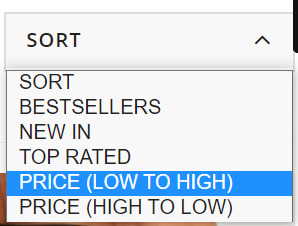
This makes sense since their purpose is to allow visitors to simply sort or narrow page content rather than offering alternative results and additional value (which is offered through faceted navigation). As such, filter typically produce duplicate results which should not be discoverable beyond the immediate moment. But this hard-and-fast rule doesn’t always apply perfectly in the real world. This is why we need to look at our individual industries and understand what’s important to our unique set of customers.
If we look at the world of gifting, we often see people shopping with a particular budget in mind. Therefore, terms like “birthday gift under £20” (40 m/s) or “Secret Santa gift under £10” (2.9k m/s) are reasonably common, and opening up relevant listing pages could be useful for shoppers.
Step 4: The technical steps
Facet taxonomies are hugely complex and the number of attributes that can be strung together increases with the size of the domain. We, therefore, need to carefully manage the flood gates and mitigate against any potential risks including crawl inefficiencies and link equity dilution.
We can do this by:
1. Avoiding thin/doorway pages by regularly re-assessing your product offering. For instance, you may consider there to be little value in creating a new listings page if you’re selling a very small range of low price point products. In this case, you may decide against opening up an additional Product Listing Page when you sell as few as 10 eligible products. However, this is not a fixed rule, so it’s quite possible that your criteria may be lower for particular product lines. Either way, these numbers will change over time. Consider seasonal trends, when new collections are launched, and when they become discontinued. Setting up a product retirement strategy to manage expired products and categories at scale in parallel with this step is also highly recommended.
2. Prevent content cannibalization by arranging selected facets according to their value and significance. “Size” is very important for some electrical goods like TVs, laptops, and cameras, but is less so for beauty accessories or vacuum cleaners. You must also make sure page content is distinctive and reflects the focus of your chosen facet(s). Refer to step 5 for more details.
3. Follow the sequence in which adjectives and facets are typically selected by your customers. This can vary depending on where your audience lives. So, whilst products generally have five or more distinguishable features, English vernacular determines that we use more than four adjectives (e.g. size + color + material + shape) to describe something.
4. Control the controllables by dealing with overlapping variations. This typically occurs when multiples co-exist and each exhibits good search metrics. For instance, it’s reasonable for someone to simultaneously look for several color and/or fabric combinations in the different ways below.

When this situation occurs, we should follow the same linguistic rules as above and choose a preferred sequence. In this case, it would be color + material + product type.
In comparison to the noindex tag suggested for on-page filters you should canonicalize unnecessary facets to their parent page (remembering that this is merely a hint and not a directive). This will enable you to control how crawlers deal with highly comparable result pages and will, therefore, help to prevent your site from being demoted in the SERPs. Dynamic search parameters should continue to be defined with a “noindex, nofollow” meta robots tag, disallowed in the robots.txt file, and configured through Google’s URL parameter tool (within your Search Console account) to tell crawlers the purpose of your parameters and how you would like them to be treated. This is a helpful guide on parameter handling for Googlebots, but bear in mind that this last tip won’t influence how Bing or Yahoo user-agents interpret these pages.
5. Open your facets in phases and cultivate it into a test-and-learn process. This will enable you to identify issues a lot sooner and implement facet-wide solutions in a timely manner. Without having to unravel these additional layers of complexity, problems such as crawl inefficiencies, PageRank dilution, or excessive indexation can be swiftly resolved.
To show you what this could look like, I’ve provided a phasing plan that was created for one of our e-commerce clients. Our research showed a significant SEO opportunity for opening up some of the facets and filters: potential +£263Kpcm for the “colour + type” facet (UK):
What’s more, when we extended our forecast to include other facet combinations, we calculated an additional revenue opportunity of up to +£207K/pcm (before filtering out combinations with no products offering).
Step 5: Optimize your facet URLs
Optimize your new facet category URLs to establish relevancy for your selected search terms. The key on-page elements to focus on include:
URL
Page title
Breadcrumb anchor texts
H tags
Content snippets (e.g. introductory text and FAQ copy)
Image ALT texts
Product names
Link out to similar facet category pages (i.e. via a “You May Also Like” feature box)
David’s Bridal is a good example of a retailer that has done this well. Looking back at the ‘Long Sleeve Wedding Dress’ Product Listing Page, we can see that they’ve curated unique content and followed fundamental optimization tactics on the landing page in a way that feels helpful to the user.
URL: davidsbridal.com/long-sleeve-wedding-dresses
Page Title: Long Sleeve Wedding Dresses & Gowns | David's Bridal
Meta Description: Do you dream of wearing a long sleeve wedding dress on your big day? Shop David's Bridal wide variety of wedding gowns with sleeves in lace & other designs!
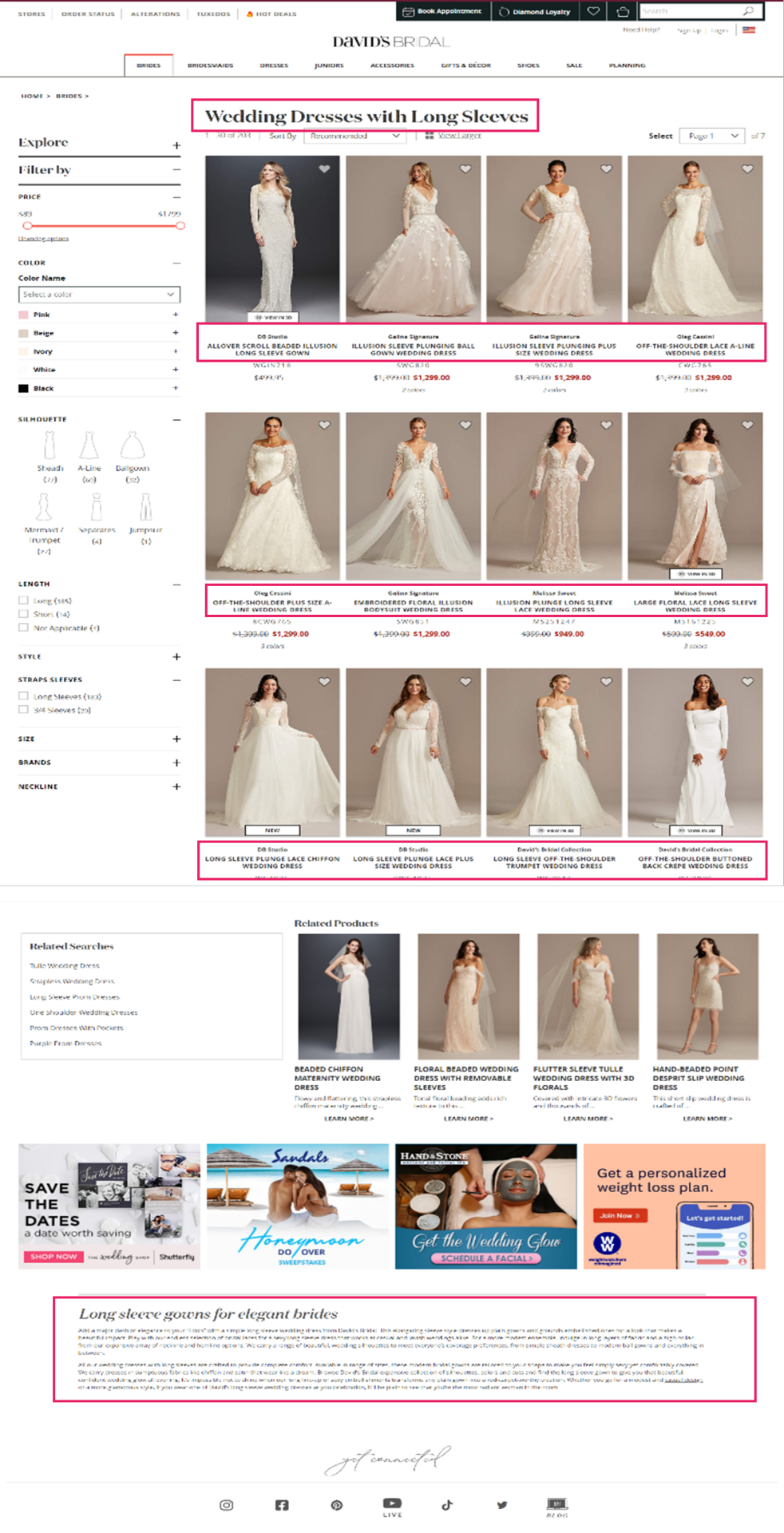
6. Provide accessibility and build page authority
Once you’ve opened up your new facet Product Listing Pages, you need to begin cultivating link equity towards them. This will ensure that they don’t exist as orphan URLs with no PageRank:
Ensure they’re referenced in your product XML sitemap.
If you have one feature per facet URL, then add them to your faceted navigation across CLP and Product Listing Page pages.
If you have two or more features per facet URL, then create a “Popular Searches” or “Related Searches” option within your CLPs.
Utilize your mega menu to showcase your new category landing pages. This will not only allow you to direct a large proportion of link equity, but it will also secure the highest click-through rate amongst your visitors.
Integrate your editorial strategy by creating engaging content with in-copy links. Think about how you can use descriptive long-tail anchor text about the Product Listing Page you want to link to rather than relying on “click here” or “see more”.
Connect to them via href links so you’re not solely relying on links from the main navigation or content hyperlinks. As this is difficult to do at scale, it can be done through modules such as “related categories”, “other subcategories”, “related products”, etc.
Devise strategic outreach campaigns that will secure quality, external backlinks to them.
Implementing this holistic and robust strategy will help you to secure exponential growth from your new commercial landing pages.
Conclusion
There is a great deal of organic opportunity that exists within your faceted navigation if you begin to leverage mid- and long-tail search terms.
Seek out the opportunity from extended keyword research and competitor analysis before deciding which variants fulfill consumer demands and deliver optimal organic sessions and onsite conversions. Configure a single faceted URL for each opportunity and open them up for crawl and indexation. Ensure PageRank is distributed to them (both internally and externally) and develop your landing page content in line with quality optimization practices. This approach will help you to avoid having crawl inefficiencies, over indexation, cannibalization, or having thin doorway pages. In turn, your website will be better suited to attract highly-targeted users and guide them down the purchase funnel.
Maximizing UX and reducing reliance on other marketing channels means that your faceted navigation can truly deliver organic ROI. We have seen this work for our clients.
0 notes
Text
Fulfill Untapped Customer Demands Through Your Faceted Navigation
Faceted navigation allows customers to narrow down search results based on specific product attributes. They typically exist on Product Listing Pages (PLPs) and are a great way to help users intuitively discover products but managing this filtering system is a common SEO challenge. Crawling and indexation need to be controlled.
However, if we look beyond their inherent functionality, facets can offer us considerable potential. By centering your secondary navigation on long-tail keyword opportunities, you’ll be able to strategically utilize consumer intent, secure additional web conversions, and boost revenue levels.
Match consumer intent with long-tail search queries
Having an established brand and a solid domain backlink profile won’t guarantee success. This is great news for smaller brands, as industry giants aren’t necessarily going to win at this game.
If we search for “long sleeve wedding dresses”, we can see how David’s Bridal’s optimized facet page (Domain Authority: 67/100, Page Authority: 47 / 100) has obtained the top ranking position, while Nordstrom’s result (Domain Authority: 87/100, Page Authority: 39/100) appears in the third position for this particular query. We’ll take a look at what makes this page so effective later.
When looking at how we can optimize faceted navigations, it’s important to recognize that product attributes convey consumer needs and aspirations. If, for example, I’m looking for a wedding dress, then I may tailor my search by the color, fabric, neckline shape, and the sleeve length.
According to the search demand curve, long-tail queries account for up to 70% of all organic searches. They are highly targeted queries that offer big traffic-driving opportunities.
In the last few years, we’ve seen a big shift in the industry towards capitalizing this intent with long-form content. Blog articles and style guides have become the go-to methods for many to capture these visitors, as we can see from the examples taken from Marks & Spencers’ "Inspire Me" section:
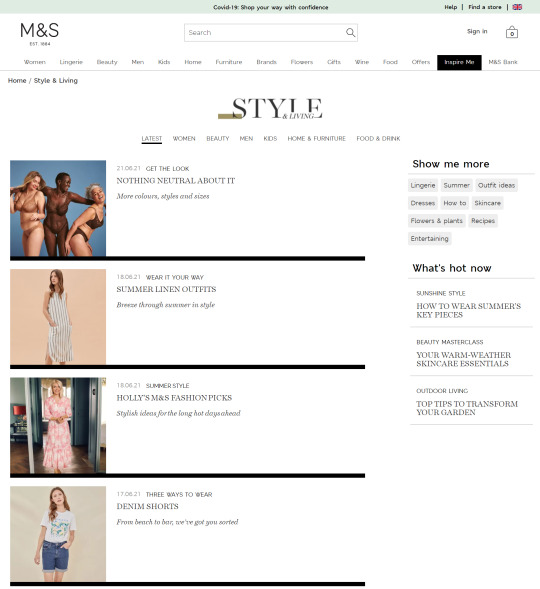
People often look for inspiration when they’re shopping, and these pages provide an effective way to add more internal links to category and product pages. But relying on this approach is one-dimensional, given that these deeper content pages tend to have lower PageRank. An extensive amount of time and effort will, therefore, be required to achieve the desired result.
In comparison, Product Listing Pages usually target broader search terms, and faceted navigations typically exist as passive functions. This is because they’re often blocked from crawlers, making them devoid of any SEO value. Waterstones (a well-known British bookstore) is one retailer that applies this rule for their on-page filters:
In this particular example, I’ve applied a filter to only show me books for 5 – 8 year olds, but the appended URL (https://www.waterstones.com/category/childrens-teenage/facet/498) is blocked in the robots.txt file. This is going to prevent such pages from being served in the SERPs despite them having the potential to meet specific customer needs. This shows that there can be a fundamental disconnect in matching customer intent to the pages we’re providing them in the organic results.
From the diagram below, we can see how editorial content typically focuses on the “awareness” and “interest” stages, whilst Product Listing Pages tend to be more in line with the “consideration” and “purchase” phases:
Serving the right content to users throughout their buying journey is pivotal to success. For many retailers, competitors are continuing to prioritize broader, high-volume keywords in saturated markets. They’re targeting the same terms to secure a proportion of the same search traffic. This is a very challenging prospect to face, and without carving out a gap in the marketplace, they won’t necessarily deliver the results they seek to secure. Likewise, relying on informational guides to target long-tail keywords means that you’re missing a large percentage of users who have very specific buying requirements. Yes, they’re ready to make a purchase!
By shifting your focus to address your customer’s real needs and expectations, you’ll be able to deliver a satisfying, frictionless experience at every interaction and all the way through to that final purchase.
The solution
Step 1: Conduct long-tail keyword research
Build a really comprehensive view of your potential customers by harnessing data from a variety of sources, including:
a) Keyword research tools like Moz, Google Keyword Planner, and Answer The Public.
b) The SERPs — get inspiration from the auto-suggest results, People Also Ask, and the related search links at the bottom of the page.
c) Competitor activity — aside from using SEO monitoring software, you can use a data mining extension tool like Scraper, which will extract faceted options directly from competitor Product Listing Pages. These tools are often free to download and allow you to quickly transfer product categories.
d) Your Google Search Console, Analytics, and PPC accounts to determine which keywords and URLs are securing the highest number of visits and web conversions. Internal search data can also give you great consumer insights.
e) Speak to your merchandising team to understand product demands and fulfillment capabilities.
Step 2: Group into meaningful sub-topics
Once you’ve collated all this information into a spreadsheet, you’ll be able to discover long-tail, consideration-orientated keywords. While individually they may not boast huge monthly search estimates, they can collectively highlight where purchase intentions can be better fulfilled.
To help illustrate this point, we can look at a small subset of lingerie keywords and the facets the searches represent:

From the table above we can quickly see a pattern emerging with color and material variations appearing across the search terms. We can then substantiate this information with session and revenue estimates with the use of a recognized CTR model. This enables us to help forecast the potential organic uplift and quantify the size of the prize for a number of different scenarios that are on offer from each new facet combination. This may include estimations for securing position 10, 7, 5, 3 and 1 in Google.
One thing to note here is that it’s worth excluding synonyms, as they will falsely inflate your calculations. An example here would be to exclude “storage drawers” (22.2k monthly searchers) when reviewing the performance for “chest of drawers” (201k m/s). Including both variants will cause a false positive result and will lead you to draw incorrect conclusions.
Step 3: Dig deeper into broader terms around offers, ratings, and price
These product filters are found in the “Sort” dropdown box and, from my experience, these are set to “noindex” from the outset as they simply allow users to re-order page results. Certainly, content management systems like Shopify and Shopware have this as a default.
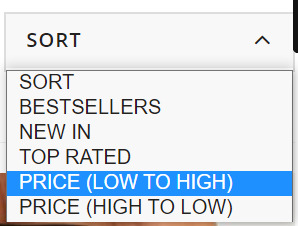
This makes sense since their purpose is to allow visitors to simply sort or narrow page content rather than offering alternative results and additional value (which is offered through faceted navigation). As such, filter typically produce duplicate results which should not be discoverable beyond the immediate moment. But this hard-and-fast rule doesn’t always apply perfectly in the real world. This is why we need to look at our individual industries and understand what’s important to our unique set of customers.
If we look at the world of gifting, we often see people shopping with a particular budget in mind. Therefore, terms like “birthday gift under £20” (40 m/s) or “Secret Santa gift under £10” (2.9k m/s) are reasonably common, and opening up relevant listing pages could be useful for shoppers.
Step 4: The technical steps
Facet taxonomies are hugely complex and the number of attributes that can be strung together increases with the size of the domain. We, therefore, need to carefully manage the flood gates and mitigate against any potential risks including crawl inefficiencies and link equity dilution.
We can do this by:
1. Avoiding thin/doorway pages by regularly re-assessing your product offering. For instance, you may consider there to be little value in creating a new listings page if you’re selling a very small range of low price point products. In this case, you may decide against opening up an additional Product Listing Page when you sell as few as 10 eligible products. However, this is not a fixed rule, so it’s quite possible that your criteria may be lower for particular product lines. Either way, these numbers will change over time. Consider seasonal trends, when new collections are launched, and when they become discontinued. Setting up a product retirement strategy to manage expired products and categories at scale in parallel with this step is also highly recommended.
2. Prevent content cannibalization by arranging selected facets according to their value and significance. “Size” is very important for some electrical goods like TVs, laptops, and cameras, but is less so for beauty accessories or vacuum cleaners. You must also make sure page content is distinctive and reflects the focus of your chosen facet(s). Refer to step 5 for more details.
3. Follow the sequence in which adjectives and facets are typically selected by your customers. This can vary depending on where your audience lives. So, whilst products generally have five or more distinguishable features, English vernacular determines that we use more than four adjectives (e.g. size + color + material + shape) to describe something.
4. Control the controllables by dealing with overlapping variations. This typically occurs when multiples co-exist and each exhibits good search metrics. For instance, it’s reasonable for someone to simultaneously look for several color and/or fabric combinations in the different ways below.

When this situation occurs, we should follow the same linguistic rules as above and choose a preferred sequence. In this case, it would be color + material + product type.
In comparison to the noindex tag suggested for on-page filters you should canonicalize unnecessary facets to their parent page (remembering that this is merely a hint and not a directive). This will enable you to control how crawlers deal with highly comparable result pages and will, therefore, help to prevent your site from being demoted in the SERPs. Dynamic search parameters should continue to be defined with a “noindex, nofollow” meta robots tag, disallowed in the robots.txt file, and configured through Google’s URL parameter tool (within your Search Console account) to tell crawlers the purpose of your parameters and how you would like them to be treated. This is a helpful guide on parameter handling for Googlebots, but bear in mind that this last tip won’t influence how Bing or Yahoo user-agents interpret these pages.
5. Open your facets in phases and cultivate it into a test-and-learn process. This will enable you to identify issues a lot sooner and implement facet-wide solutions in a timely manner. Without having to unravel these additional layers of complexity, problems such as crawl inefficiencies, PageRank dilution, or excessive indexation can be swiftly resolved.
To show you what this could look like, I’ve provided a phasing plan that was created for one of our e-commerce clients. Our research showed a significant SEO opportunity for opening up some of the facets and filters: potential +£263Kpcm for the “colour + type” facet (UK):
What’s more, when we extended our forecast to include other facet combinations, we calculated an additional revenue opportunity of up to +£207K/pcm (before filtering out combinations with no products offering).
Step 5: Optimize your facet URLs
Optimize your new facet category URLs to establish relevancy for your selected search terms. The key on-page elements to focus on include:
URL
Page title
Breadcrumb anchor texts
H tags
Content snippets (e.g. introductory text and FAQ copy)
Image ALT texts
Product names
Link out to similar facet category pages (i.e. via a “You May Also Like” feature box)
David’s Bridal is a good example of a retailer that has done this well. Looking back at the ‘Long Sleeve Wedding Dress’ Product Listing Page, we can see that they’ve curated unique content and followed fundamental optimization tactics on the landing page in a way that feels helpful to the user.
URL: davidsbridal.com/long-sleeve-wedding-dresses
Page Title: Long Sleeve Wedding Dresses & Gowns | David's Bridal
Meta Description: Do you dream of wearing a long sleeve wedding dress on your big day? Shop David's Bridal wide variety of wedding gowns with sleeves in lace & other designs!
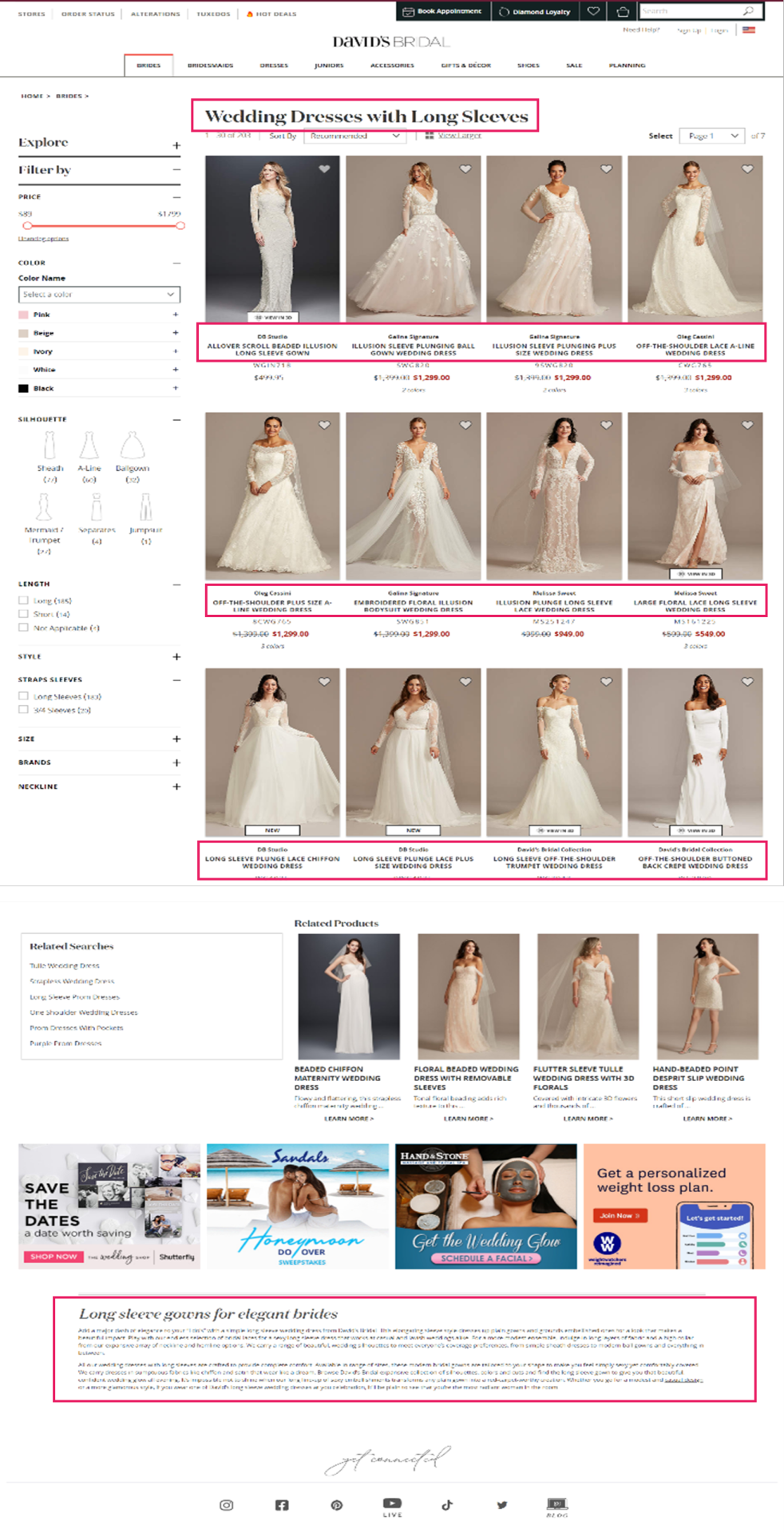
6. Provide accessibility and build page authority
Once you’ve opened up your new facet Product Listing Pages, you need to begin cultivating link equity towards them. This will ensure that they don’t exist as orphan URLs with no PageRank:
Ensure they’re referenced in your product XML sitemap.
If you have one feature per facet URL, then add them to your faceted navigation across CLP and Product Listing Page pages.
If you have two or more features per facet URL, then create a “Popular Searches” or “Related Searches” option within your CLPs.
Utilize your mega menu to showcase your new category landing pages. This will not only allow you to direct a large proportion of link equity, but it will also secure the highest click-through rate amongst your visitors.
Integrate your editorial strategy by creating engaging content with in-copy links. Think about how you can use descriptive long-tail anchor text about the Product Listing Page you want to link to rather than relying on “click here” or “see more”.
Connect to them via href links so you’re not solely relying on links from the main navigation or content hyperlinks. As this is difficult to do at scale, it can be done through modules such as “related categories”, “other subcategories”, “related products”, etc.
Devise strategic outreach campaigns that will secure quality, external backlinks to them.
Implementing this holistic and robust strategy will help you to secure exponential growth from your new commercial landing pages.
Conclusion
There is a great deal of organic opportunity that exists within your faceted navigation if you begin to leverage mid- and long-tail search terms.
Seek out the opportunity from extended keyword research and competitor analysis before deciding which variants fulfill consumer demands and deliver optimal organic sessions and onsite conversions. Configure a single faceted URL for each opportunity and open them up for crawl and indexation. Ensure PageRank is distributed to them (both internally and externally) and develop your landing page content in line with quality optimization practices. This approach will help you to avoid having crawl inefficiencies, over indexation, cannibalization, or having thin doorway pages. In turn, your website will be better suited to attract highly-targeted users and guide them down the purchase funnel.
Maximizing UX and reducing reliance on other marketing channels means that your faceted navigation can truly deliver organic ROI. We have seen this work for our clients.
0 notes
Text
Fulfill Untapped Customer Demands Through Your Faceted Navigation
Faceted navigation allows customers to narrow down search results based on specific product attributes. They typically exist on Product Listing Pages (PLPs) and are a great way to help users intuitively discover products but managing this filtering system is a common SEO challenge. Crawling and indexation need to be controlled.
However, if we look beyond their inherent functionality, facets can offer us considerable potential. By centering your secondary navigation on long-tail keyword opportunities, you’ll be able to strategically utilize consumer intent, secure additional web conversions, and boost revenue levels.
Match consumer intent with long-tail search queries
Having an established brand and a solid domain backlink profile won’t guarantee success. This is great news for smaller brands, as industry giants aren’t necessarily going to win at this game.
If we search for “long sleeve wedding dresses”, we can see how David’s Bridal’s optimized facet page (Domain Authority: 67/100, Page Authority: 47 / 100) has obtained the top ranking position, while Nordstrom’s result (Domain Authority: 87/100, Page Authority: 39/100) appears in the third position for this particular query. We’ll take a look at what makes this page so effective later.
When looking at how we can optimize faceted navigations, it’s important to recognize that product attributes convey consumer needs and aspirations. If, for example, I’m looking for a wedding dress, then I may tailor my search by the color, fabric, neckline shape, and the sleeve length.
According to the search demand curve, long-tail queries account for up to 70% of all organic searches. They are highly targeted queries that offer big traffic-driving opportunities.
In the last few years, we’ve seen a big shift in the industry towards capitalizing this intent with long-form content. Blog articles and style guides have become the go-to methods for many to capture these visitors, as we can see from the examples taken from Marks & Spencers’ "Inspire Me" section:

People often look for inspiration when they’re shopping, and these pages provide an effective way to add more internal links to category and product pages. But relying on this approach is one-dimensional, given that these deeper content pages tend to have lower PageRank. An extensive amount of time and effort will, therefore, be required to achieve the desired result.
In comparison, Product Listing Pages usually target broader search terms, and faceted navigations typically exist as passive functions. This is because they’re often blocked from crawlers, making them devoid of any SEO value. Waterstones (a well-known British bookstore) is one retailer that applies this rule for their on-page filters:
In this particular example, I’ve applied a filter to only show me books for 5 – 8 year olds, but the appended URL (https://ift.tt/3xrpOJS) is blocked in the robots.txt file. This is going to prevent such pages from being served in the SERPs despite them having the potential to meet specific customer needs. This shows that there can be a fundamental disconnect in matching customer intent to the pages we’re providing them in the organic results.
From the diagram below, we can see how editorial content typically focuses on the “awareness” and “interest” stages, whilst Product Listing Pages tend to be more in line with the “consideration” and “purchase” phases:
Serving the right content to users throughout their buying journey is pivotal to success. For many retailers, competitors are continuing to prioritize broader, high-volume keywords in saturated markets. They’re targeting the same terms to secure a proportion of the same search traffic. This is a very challenging prospect to face, and without carving out a gap in the marketplace, they won’t necessarily deliver the results they seek to secure. Likewise, relying on informational guides to target long-tail keywords means that you’re missing a large percentage of users who have very specific buying requirements. Yes, they’re ready to make a purchase!
By shifting your focus to address your customer’s real needs and expectations, you’ll be able to deliver a satisfying, frictionless experience at every interaction and all the way through to that final purchase.
The solution
Step 1: Conduct long-tail keyword research
Build a really comprehensive view of your potential customers by harnessing data from a variety of sources, including:
a) Keyword research tools like Moz, Google Keyword Planner, and Answer The Public.
b) The SERPs — get inspiration from the auto-suggest results, People Also Ask, and the related search links at the bottom of the page.
c) Competitor activity — aside from using SEO monitoring software, you can use a data mining extension tool like Scraper, which will extract faceted options directly from competitor Product Listing Pages. These tools are often free to download and allow you to quickly transfer product categories.
d) Your Google Search Console, Analytics, and PPC accounts to determine which keywords and URLs are securing the highest number of visits and web conversions. Internal search data can also give you great consumer insights.
e) Speak to your merchandising team to understand product demands and fulfillment capabilities.
Step 2: Group into meaningful sub-topics
Once you’ve collated all this information into a spreadsheet, you’ll be able to discover long-tail, consideration-orientated keywords. While individually they may not boast huge monthly search estimates, they can collectively highlight where purchase intentions can be better fulfilled.
To help illustrate this point, we can look at a small subset of lingerie keywords and the facets the searches represent:

From the table above we can quickly see a pattern emerging with color and material variations appearing across the search terms. We can then substantiate this information with session and revenue estimates with the use of a recognized CTR model. This enables us to help forecast the potential organic uplift and quantify the size of the prize for a number of different scenarios that are on offer from each new facet combination. This may include estimations for securing position 10, 7, 5, 3 and 1 in Google.
One thing to note here is that it’s worth excluding synonyms, as they will falsely inflate your calculations. An example here would be to exclude “storage drawers” (22.2k monthly searchers) when reviewing the performance for “chest of drawers” (201k m/s). Including both variants will cause a false positive result and will lead you to draw incorrect conclusions.
Step 3: Dig deeper into broader terms around offers, ratings, and price
These product filters are found in the “Sort” dropdown box and, from my experience, these are set to “noindex” from the outset as they simply allow users to re-order page results. Certainly, content management systems like Shopify and Shopware have this as a default.

This makes sense since their purpose is to allow visitors to simply sort or narrow page content rather than offering alternative results and additional value (which is offered through faceted navigation). As such, filter typically produce duplicate results which should not be discoverable beyond the immediate moment. But this hard-and-fast rule doesn’t always apply perfectly in the real world. This is why we need to look at our individual industries and understand what’s important to our unique set of customers.
If we look at the world of gifting, we often see people shopping with a particular budget in mind. Therefore, terms like “birthday gift under £20” (40 m/s) or “Secret Santa gift under £10” (2.9k m/s) are reasonably common, and opening up relevant listing pages could be useful for shoppers.
Step 4: The technical steps
Facet taxonomies are hugely complex and the number of attributes that can be strung together increases with the size of the domain. We, therefore, need to carefully manage the flood gates and mitigate against any potential risks including crawl inefficiencies and link equity dilution.
We can do this by:
1. Avoiding thin/doorway pages by regularly re-assessing your product offering. For instance, you may consider there to be little value in creating a new listings page if you’re selling a very small range of low price point products. In this case, you may decide against opening up an additional Product Listing Page when you sell as few as 10 eligible products. However, this is not a fixed rule, so it’s quite possible that your criteria may be lower for particular product lines. Either way, these numbers will change over time. Consider seasonal trends, when new collections are launched, and when they become discontinued. Setting up a product retirement strategy to manage expired products and categories at scale in parallel with this step is also highly recommended.
2. Prevent content cannibalization by arranging selected facets according to their value and significance. “Size” is very important for some electrical goods like TVs, laptops, and cameras, but is less so for beauty accessories or vacuum cleaners. You must also make sure page content is distinctive and reflects the focus of your chosen facet(s). Refer to step 5 for more details.
3. Follow the sequence in which adjectives and facets are typically selected by your customers. This can vary depending on where your audience lives. So, whilst products generally have five or more distinguishable features, English vernacular determines that we use more than four adjectives (e.g. size + color + material + shape) to describe something.
4. Control the controllables by dealing with overlapping variations. This typically occurs when multiples co-exist and each exhibits good search metrics. For instance, it’s reasonable for someone to simultaneously look for several color and/or fabric combinations in the different ways below.

When this situation occurs, we should follow the same linguistic rules as above and choose a preferred sequence. In this case, it would be color + material + product type.
In comparison to the noindex tag suggested for on-page filters you should canonicalize unnecessary facets to their parent page (remembering that this is merely a hint and not a directive). This will enable you to control how crawlers deal with highly comparable result pages and will, therefore, help to prevent your site from being demoted in the SERPs. Dynamic search parameters should continue to be defined with a “noindex, nofollow” meta robots tag, disallowed in the robots.txt file, and configured through Google’s URL parameter tool (within your Search Console account) to tell crawlers the purpose of your parameters and how you would like them to be treated. This is a helpful guide on parameter handling for Googlebots, but bear in mind that this last tip won’t influence how Bing or Yahoo user-agents interpret these pages.
5. Open your facets in phases and cultivate it into a test-and-learn process. This will enable you to identify issues a lot sooner and implement facet-wide solutions in a timely manner. Without having to unravel these additional layers of complexity, problems such as crawl inefficiencies, PageRank dilution, or excessive indexation can be swiftly resolved.
To show you what this could look like, I’ve provided a phasing plan that was created for one of our e-commerce clients. Our research showed a significant SEO opportunity for opening up some of the facets and filters: potential +£263Kpcm for the “colour + type” facet (UK):
What’s more, when we extended our forecast to include other facet combinations, we calculated an additional revenue opportunity of up to +£207K/pcm (before filtering out combinations with no products offering).
Step 5: Optimize your facet URLs
Optimize your new facet category URLs to establish relevancy for your selected search terms. The key on-page elements to focus on include:
URL
Page title
Breadcrumb anchor texts
H tags
Content snippets (e.g. introductory text and FAQ copy)
Image ALT texts
Product names
Link out to similar facet category pages (i.e. via a “You May Also Like” feature box)
David’s Bridal is a good example of a retailer that has done this well. Looking back at the ‘Long Sleeve Wedding Dress’ Product Listing Page, we can see that they’ve curated unique content and followed fundamental optimization tactics on the landing page in a way that feels helpful to the user.
URL: davidsbridal.com/long-sleeve-wedding-dresses
Page Title: Long Sleeve Wedding Dresses & Gowns | David's Bridal
Meta Description: Do you dream of wearing a long sleeve wedding dress on your big day? Shop David's Bridal wide variety of wedding gowns with sleeves in lace & other designs!
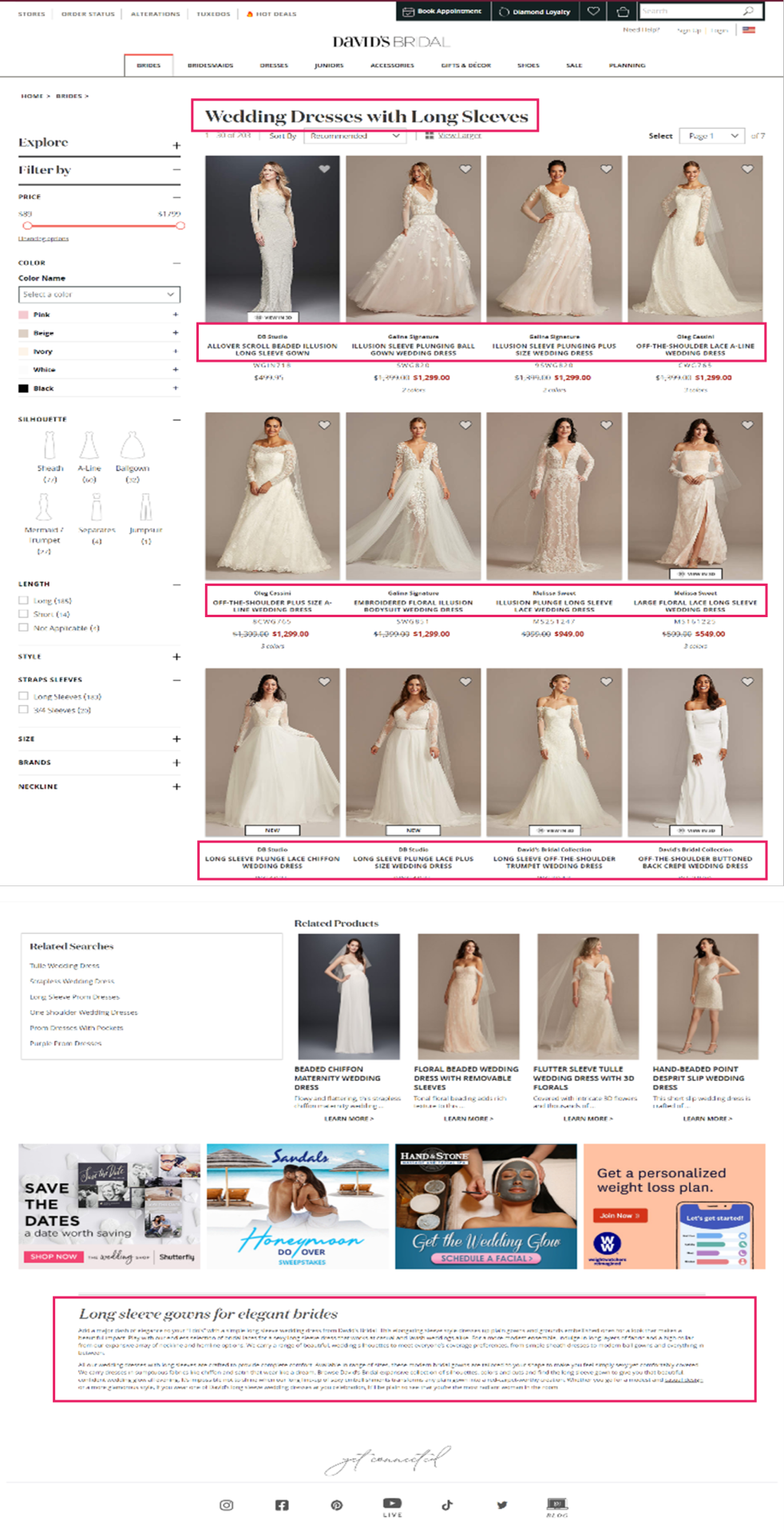
6. Provide accessibility and build page authority
Once you’ve opened up your new facet Product Listing Pages, you need to begin cultivating link equity towards them. This will ensure that they don’t exist as orphan URLs with no PageRank:
Ensure they’re referenced in your product XML sitemap.
If you have one feature per facet URL, then add them to your faceted navigation across CLP and Product Listing Page pages.
If you have two or more features per facet URL, then create a “Popular Searches” or “Related Searches” option within your CLPs.
Utilize your mega menu to showcase your new category landing pages. This will not only allow you to direct a large proportion of link equity, but it will also secure the highest click-through rate amongst your visitors.
Integrate your editorial strategy by creating engaging content with in-copy links. Think about how you can use descriptive long-tail anchor text about the Product Listing Page you want to link to rather than relying on “click here” or “see more”.
Connect to them via href links so you’re not solely relying on links from the main navigation or content hyperlinks. As this is difficult to do at scale, it can be done through modules such as “related categories”, “other subcategories”, “related products”, etc.
Devise strategic outreach campaigns that will secure quality, external backlinks to them.
Implementing this holistic and robust strategy will help you to secure exponential growth from your new commercial landing pages.
Conclusion
There is a great deal of organic opportunity that exists within your faceted navigation if you begin to leverage mid- and long-tail search terms.
Seek out the opportunity from extended keyword research and competitor analysis before deciding which variants fulfill consumer demands and deliver optimal organic sessions and onsite conversions. Configure a single faceted URL for each opportunity and open them up for crawl and indexation. Ensure PageRank is distributed to them (both internally and externally) and develop your landing page content in line with quality optimization practices. This approach will help you to avoid having crawl inefficiencies, over indexation, cannibalization, or having thin doorway pages. In turn, your website will be better suited to attract highly-targeted users and guide them down the purchase funnel.
Maximizing UX and reducing reliance on other marketing channels means that your faceted navigation can truly deliver organic ROI. We have seen this work for our clients.
0 notes
Text
Fulfill Untapped Customer Demands Through Your Faceted Navigation
Faceted navigation allows customers to narrow down search results based on specific product attributes. They typically exist on Product Listing Pages (PLPs) and are a great way to help users intuitively discover products but managing this filtering system is a common SEO challenge. Crawling and indexation need to be controlled.
However, if we look beyond their inherent functionality, facets can offer us considerable potential. By centering your secondary navigation on long-tail keyword opportunities, you’ll be able to strategically utilize consumer intent, secure additional web conversions, and boost revenue levels.
Match consumer intent with long-tail search queries
Having an established brand and a solid domain backlink profile won’t guarantee success. This is great news for smaller brands, as industry giants aren’t necessarily going to win at this game.
If we search for “long sleeve wedding dresses”, we can see how David’s Bridal’s optimized facet page (Domain Authority: 67/100, Page Authority: 47 / 100) has obtained the top ranking position, while Nordstrom’s result (Domain Authority: 87/100, Page Authority: 39/100) appears in the third position for this particular query. We’ll take a look at what makes this page so effective later.
When looking at how we can optimize faceted navigations, it’s important to recognize that product attributes convey consumer needs and aspirations. If, for example, I’m looking for a wedding dress, then I may tailor my search by the color, fabric, neckline shape, and the sleeve length.
According to the search demand curve, long-tail queries account for up to 70% of all organic searches. They are highly targeted queries that offer big traffic-driving opportunities.
In the last few years, we’ve seen a big shift in the industry towards capitalizing this intent with long-form content. Blog articles and style guides have become the go-to methods for many to capture these visitors, as we can see from the examples taken from Marks & Spencers’ "Inspire Me" section:

People often look for inspiration when they’re shopping, and these pages provide an effective way to add more internal links to category and product pages. But relying on this approach is one-dimensional, given that these deeper content pages tend to have lower PageRank. An extensive amount of time and effort will, therefore, be required to achieve the desired result.
In comparison, Product Listing Pages usually target broader search terms, and faceted navigations typically exist as passive functions. This is because they’re often blocked from crawlers, making them devoid of any SEO value. Waterstones (a well-known British bookstore) is one retailer that applies this rule for their on-page filters:
In this particular example, I’ve applied a filter to only show me books for 5 – 8 year olds, but the appended URL (https://ift.tt/3xrpOJS) is blocked in the robots.txt file. This is going to prevent such pages from being served in the SERPs despite them having the potential to meet specific customer needs. This shows that there can be a fundamental disconnect in matching customer intent to the pages we’re providing them in the organic results.
From the diagram below, we can see how editorial content typically focuses on the “awareness” and “interest” stages, whilst Product Listing Pages tend to be more in line with the “consideration” and “purchase” phases:
Serving the right content to users throughout their buying journey is pivotal to success. For many retailers, competitors are continuing to prioritize broader, high-volume keywords in saturated markets. They’re targeting the same terms to secure a proportion of the same search traffic. This is a very challenging prospect to face, and without carving out a gap in the marketplace, they won’t necessarily deliver the results they seek to secure. Likewise, relying on informational guides to target long-tail keywords means that you’re missing a large percentage of users who have very specific buying requirements. Yes, they’re ready to make a purchase!
By shifting your focus to address your customer’s real needs and expectations, you’ll be able to deliver a satisfying, frictionless experience at every interaction and all the way through to that final purchase.
The solution
Step 1: Conduct long-tail keyword research
Build a really comprehensive view of your potential customers by harnessing data from a variety of sources, including:
a) Keyword research tools like Moz, Google Keyword Planner, and Answer The Public.
b) The SERPs — get inspiration from the auto-suggest results, People Also Ask, and the related search links at the bottom of the page.
c) Competitor activity — aside from using SEO monitoring software, you can use a data mining extension tool like Scraper, which will extract faceted options directly from competitor Product Listing Pages. These tools are often free to download and allow you to quickly transfer product categories.
d) Your Google Search Console, Analytics, and PPC accounts to determine which keywords and URLs are securing the highest number of visits and web conversions. Internal search data can also give you great consumer insights.
e) Speak to your merchandising team to understand product demands and fulfillment capabilities.
Step 2: Group into meaningful sub-topics
Once you’ve collated all this information into a spreadsheet, you’ll be able to discover long-tail, consideration-orientated keywords. While individually they may not boast huge monthly search estimates, they can collectively highlight where purchase intentions can be better fulfilled.
To help illustrate this point, we can look at a small subset of lingerie keywords and the facets the searches represent:
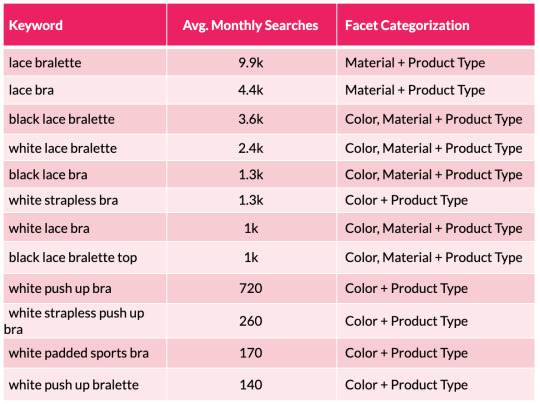
From the table above we can quickly see a pattern emerging with color and material variations appearing across the search terms. We can then substantiate this information with session and revenue estimates with the use of a recognized CTR model. This enables us to help forecast the potential organic uplift and quantify the size of the prize for a number of different scenarios that are on offer from each new facet combination. This may include estimations for securing position 10, 7, 5, 3 and 1 in Google.
One thing to note here is that it’s worth excluding synonyms, as they will falsely inflate your calculations. An example here would be to exclude “storage drawers” (22.2k monthly searchers) when reviewing the performance for “chest of drawers” (201k m/s). Including both variants will cause a false positive result and will lead you to draw incorrect conclusions.
Step 3: Dig deeper into broader terms around offers, ratings, and price
These product filters are found in the “Sort” dropdown box and, from my experience, these are set to “noindex” from the outset as they simply allow users to re-order page results. Certainly, content management systems like Shopify and Shopware have this as a default.

This makes sense since their purpose is to allow visitors to simply sort or narrow page content rather than offering alternative results and additional value (which is offered through faceted navigation). As such, filter typically produce duplicate results which should not be discoverable beyond the immediate moment. But this hard-and-fast rule doesn’t always apply perfectly in the real world. This is why we need to look at our individual industries and understand what’s important to our unique set of customers.
If we look at the world of gifting, we often see people shopping with a particular budget in mind. Therefore, terms like “birthday gift under £20” (40 m/s) or “Secret Santa gift under £10” (2.9k m/s) are reasonably common, and opening up relevant listing pages could be useful for shoppers.
Step 4: The technical steps
Facet taxonomies are hugely complex and the number of attributes that can be strung together increases with the size of the domain. We, therefore, need to carefully manage the flood gates and mitigate against any potential risks including crawl inefficiencies and link equity dilution.
We can do this by:
1. Avoiding thin/doorway pages by regularly re-assessing your product offering. For instance, you may consider there to be little value in creating a new listings page if you’re selling a very small range of low price point products. In this case, you may decide against opening up an additional Product Listing Page when you sell as few as 10 eligible products. However, this is not a fixed rule, so it’s quite possible that your criteria may be lower for particular product lines. Either way, these numbers will change over time. Consider seasonal trends, when new collections are launched, and when they become discontinued. Setting up a product retirement strategy to manage expired products and categories at scale in parallel with this step is also highly recommended.
2. Prevent content cannibalization by arranging selected facets according to their value and significance. “Size” is very important for some electrical goods like TVs, laptops, and cameras, but is less so for beauty accessories or vacuum cleaners. You must also make sure page content is distinctive and reflects the focus of your chosen facet(s). Refer to step 5 for more details.
3. Follow the sequence in which adjectives and facets are typically selected by your customers. This can vary depending on where your audience lives. So, whilst products generally have five or more distinguishable features, English vernacular determines that we use more than four adjectives (e.g. size + color + material + shape) to describe something.
4. Control the controllables by dealing with overlapping variations. This typically occurs when multiples co-exist and each exhibits good search metrics. For instance, it’s reasonable for someone to simultaneously look for several color and/or fabric combinations in the different ways below.
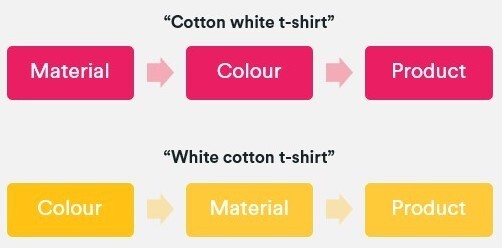
When this situation occurs, we should follow the same linguistic rules as above and choose a preferred sequence. In this case, it would be color + material + product type.
In comparison to the noindex tag suggested for on-page filters you should canonicalize unnecessary facets to their parent page (remembering that this is merely a hint and not a directive). This will enable you to control how crawlers deal with highly comparable result pages and will, therefore, help to prevent your site from being demoted in the SERPs. Dynamic search parameters should continue to be defined with a “noindex, nofollow” meta robots tag, disallowed in the robots.txt file, and configured through Google’s URL parameter tool (within your Search Console account) to tell crawlers the purpose of your parameters and how you would like them to be treated. This is a helpful guide on parameter handling for Googlebots, but bear in mind that this last tip won’t influence how Bing or Yahoo user-agents interpret these pages.
5. Open your facets in phases and cultivate it into a test-and-learn process. This will enable you to identify issues a lot sooner and implement facet-wide solutions in a timely manner. Without having to unravel these additional layers of complexity, problems such as crawl inefficiencies, PageRank dilution, or excessive indexation can be swiftly resolved.
To show you what this could look like, I’ve provided a phasing plan that was created for one of our e-commerce clients. Our research showed a significant SEO opportunity for opening up some of the facets and filters: potential +£263Kpcm for the “colour + type” facet (UK):
What’s more, when we extended our forecast to include other facet combinations, we calculated an additional revenue opportunity of up to +£207K/pcm (before filtering out combinations with no products offering).
Step 5: Optimize your facet URLs
Optimize your new facet category URLs to establish relevancy for your selected search terms. The key on-page elements to focus on include:
URL
Page title
Breadcrumb anchor texts
H tags
Content snippets (e.g. introductory text and FAQ copy)
Image ALT texts
Product names
Link out to similar facet category pages (i.e. via a “You May Also Like” feature box)
David’s Bridal is a good example of a retailer that has done this well. Looking back at the ‘Long Sleeve Wedding Dress’ Product Listing Page, we can see that they’ve curated unique content and followed fundamental optimization tactics on the landing page in a way that feels helpful to the user.
URL: davidsbridal.com/long-sleeve-wedding-dresses
Page Title: Long Sleeve Wedding Dresses & Gowns | David's Bridal
Meta Description: Do you dream of wearing a long sleeve wedding dress on your big day? Shop David's Bridal wide variety of wedding gowns with sleeves in lace & other designs!

6. Provide accessibility and build page authority
Once you’ve opened up your new facet Product Listing Pages, you need to begin cultivating link equity towards them. This will ensure that they don’t exist as orphan URLs with no PageRank:
Ensure they’re referenced in your product XML sitemap.
If you have one feature per facet URL, then add them to your faceted navigation across CLP and Product Listing Page pages.
If you have two or more features per facet URL, then create a “Popular Searches” or “Related Searches” option within your CLPs.
Utilize your mega menu to showcase your new category landing pages. This will not only allow you to direct a large proportion of link equity, but it will also secure the highest click-through rate amongst your visitors.
Integrate your editorial strategy by creating engaging content with in-copy links. Think about how you can use descriptive long-tail anchor text about the Product Listing Page you want to link to rather than relying on “click here” or “see more”.
Connect to them via href links so you’re not solely relying on links from the main navigation or content hyperlinks. As this is difficult to do at scale, it can be done through modules such as “related categories”, “other subcategories”, “related products”, etc.
Devise strategic outreach campaigns that will secure quality, external backlinks to them.
Implementing this holistic and robust strategy will help you to secure exponential growth from your new commercial landing pages.
Conclusion
There is a great deal of organic opportunity that exists within your faceted navigation if you begin to leverage mid- and long-tail search terms.
Seek out the opportunity from extended keyword research and competitor analysis before deciding which variants fulfill consumer demands and deliver optimal organic sessions and onsite conversions. Configure a single faceted URL for each opportunity and open them up for crawl and indexation. Ensure PageRank is distributed to them (both internally and externally) and develop your landing page content in line with quality optimization practices. This approach will help you to avoid having crawl inefficiencies, over indexation, cannibalization, or having thin doorway pages. In turn, your website will be better suited to attract highly-targeted users and guide them down the purchase funnel.
Maximizing UX and reducing reliance on other marketing channels means that your faceted navigation can truly deliver organic ROI. We have seen this work for our clients.
0 notes
Photo






2020 Toyota Fortuner Crusade Review
Does it represent good value for the price? What features does it come with?
The Crusade has a 2.8-litre four-cylinder turbo-diesel engine (130kW@3400rpm /450Nm@1600rpm to 2400rpm), a six-speed automatic transmission, part-time four-wheel drive and a rear diff lock.
It has climate-control air conditioning, 11-speaker JBL audio system, a 220V accessory connector, 18-inch alloys, side steps, roof rails, LED daytime running lights, and its exterior colour is glacier white, a standard colour.
The front seats are heated and eight-way power-adjustable.
It has a few fancy touches like – such as chrome all over the place, paddle shifters, and a power tailgate.
What are the key stats for the engine and transmission?
The Toyota Fortuner for sale’s 2.8-litre four-cylinder turbo-diesel engine and six-speed auto generally work adequately together – a pairing that is more slow than smooth. The 4WD system is reliably effective.
How practical is the space inside?
There are soft-touch surfaces everywhere, the interior is leather-accented, there’s a woodgrain-look to the instrument panel highlights, and a bit of hand-stitching in the seats and door trims and around the interior.
The front seats are heated and the driver’s seat is power-adjustable.
There’s a 7.0-inch touchscreen multimedia system – not really big enough or clear enough – and a 4.2-inch colour driver’s display.
The Fortuner does not have Apple Carplay or Android Auto.
There are storage spaces upfront – including these pop-out cup-holders – and enough USB points to keep your phones charged.
The Fortuner’s seven seats are in a 2-3-2 configuration. The 60/40 split-fold second-row seat has a one-touch, tumble feature while the 50/50 third-row seats are stowable. (More about that two paragraphs below.)
Boot space is claimed to be 200 litres with the third-row seats in use. In the boot, you get a 12v socket and cargo hooks.
Stowaway the third-row and cargo space increase to 716 litres.
With the second-row folded forward and somewhat out of the way, there’s a claimed 1080 litres of cargo space.
All three rows get aircon – there are roof-mounted vents – and there are a few handy storage spaces in the third row.
In the second row, comfort levels are great – sitting behind my driving position, I had ample knee room, and head and shoulder room weren’t to be sniffed at either.
The second row has two ISOFIX and three top tether anchors.
There are cup holders in this fold-down armrest as well as controls for the aircon above.
What's it like as a daily driver?
The Crusade is 4795mm long (with a 2750mm wheelbase), 1855mm wide, 1835mm high and has a listed kerb weight of 2135kg.
The driver position is high and there’s plenty of all-round visibilit.
It’s reasonably quiet, but there’s some wind noise around the wing mirrors and engine noise is a constant soundtrack.
Ride is good, with its coil-spring suspension sorting everything evenly, except for more severe bumps when it feels like the bump stops cop a solid bashing.
What's it like for touring?
Before we get stuck into it, here are the Fortuner’s off-road measures: ground clearance (225mm), approach angle (30 degrees), departure angle (25 degrees), ramp over angle (23.5 degrees), wading depth (700mm)
The Toyota Fortuner is very capable off-road.
I took it through some rough terrain – rocky tracks, deep ruts and uphills and downhills – nothing extreme, but tough enough. The Fortuner is no hard-core rock-crawler, but for a suburban-focussed 4WD wagon it does well.
The switchable 4WD system has high (4H) and low range (4L). There’s plenty of low-end torque for smooth low-speed off-roading and the turbo-diesel engine just keeps the Fortuner moving, without fuss.
The mechanicals are all fine – its 4WD set-up is always on song. You do, however, always have to drive to take into account the Fortuner’s inhibiting factors – its big side steps and low stance.
The Crusade’s traction control is effective at limiting wheelspin and helping to keep you trucking along – and if you need more traction you can always use the rear diff lock.
Besides, wheel travel is good enough to drop a tyre to the dirt, even through deeper ruts.
It has a 11.6m turning circle, so it’s not necessarily light on its feet in the bush, but it’s definitely manoeuvrable.
The Fortuner has a 750kg unbraked towing capacity and 2800kg braked towing capacity. Some of its rivals can legally tow 3100kg.
New Fortuners have a diesel particulate filter (DPF) Diesel Particulate Filter switch, so you can do a forced burn-off yourself to hopefully avoid any DPF issues.
How much fuel does it consume?
Fuel consumption is a claimed 8.6L/100km on a combined cycle.
I recorded 9.3L/100km fill to fill after almost 300km of driving, including 15km of low-range 4WDing. The Fortuner has an 80-litre fuel tank.
What safety equipment is fitted? What safety rating?
All versions of the Fortuner have a maximum five-star ANCAP safety rating, based on the latest standards.
Safety gear now includes auto emergency braking with pedestrian and cyclist detection, seven airbags, those second-row ISOFIX child-restraint anchorage points, reversing camera and rear parking sensors (none in the front), Active Cruise Control, Lane Departure Alert, Road Sign Assist and more.
The Fortuner does not have blind-spot warning, rear-cross traffic alert, or front parking sensors.
What does it cost to own? What warranty is offered?
The Fortuner range has a five-year, unlimited-kilometre warranty. Servicing intervals are six months/10,000km.
Look for a quality Fortuner for sale at Group 1 Cars, because their vehicles go through a vigorous testing process to ensure top-quality used cars at great prices.
Article sourced from: https://www.carsguide.com.au
0 notes